Rolls-Royce pre-eminent Aero Engine Maker and their cars.
Moderators: hot66, Miggs, 58A - 71E, impmad2000, drummerboytom, Barry, Helen, Viv_Surby, Derek, KS, abm914, Mike Usiskin
-
keith fellowes
- DDK forever
- Posts: 538
- Joined: Sun Feb 29, 2004 10:10 am
Re: Rolls-Royce pre-eminent Aero Engine Maker and their cars
The Jaguar MkV was probably my father's favorite car. Loved the shape and the 3.5 litre engine!
Interesting that it was essentially a 1936 design, but with losing 6-7 years because of the war it wasn't that old a design.
He tried to teach my mother to drive in it, but it was either lessons or divorce. The latter was going to be too expensive!
I find it amazing that the Belgians and Dutch have so many British cars tucked away. Pity the MkV is green
Interesting that it was essentially a 1936 design, but with losing 6-7 years because of the war it wasn't that old a design.
He tried to teach my mother to drive in it, but it was either lessons or divorce. The latter was going to be too expensive!
I find it amazing that the Belgians and Dutch have so many British cars tucked away. Pity the MkV is green
Re: Rolls-Royce pre-eminent Aero Engine Maker and their cars
Thanks Keith, it was a beautiful car, I’m biased obviously as I like most things Blatchley! I did come in other colours you know….
Anyway, I’ve found a copy of Johns Gurney Nutting Design (early cos its signed JB not JPB) that I believe was the basis for the Jag MkV, I hope you can see where I’m coming from.

So onto tonight’s twisting tale of intrigue.
Pre-war there were hundreds of Coachbuilders across the globe and a select few (mainly the good ones) got to body Rolls-Royce & Bentley Chassis. Last time I touched upon Germany, who I will end with this evening, but first lets look at Pininfarina
Pininfarina had a good working relationship with Rolls-Royce and had many Chassis delivered to them on behalf of wealthy Swiss, Italian and discerning Europeans.
They even produced design catalogues of Rolls-Royce & Bentley body designs.
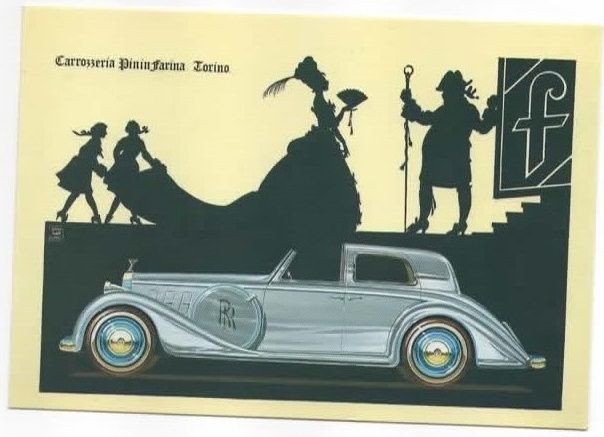
In the 20’s and early 30’s they tended to be in keeping with general expectations of Rolls-Royce and although elegant, hadn’t found that Pininfarina identity yet as this Phantom shows.
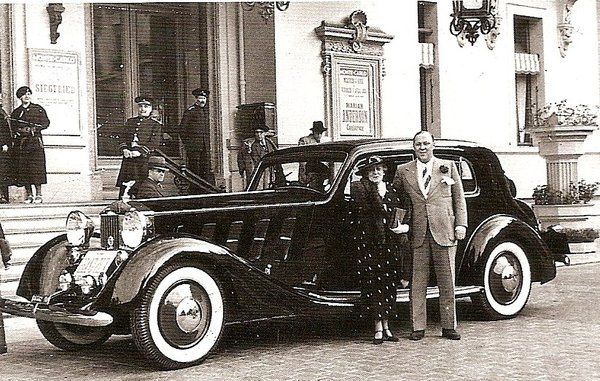
In the mid 30’s they started to gain in confidence and the Pininfarina styling cues started to appear. You can see clearly in this 1937 the “italianization” of the sloping radiator.
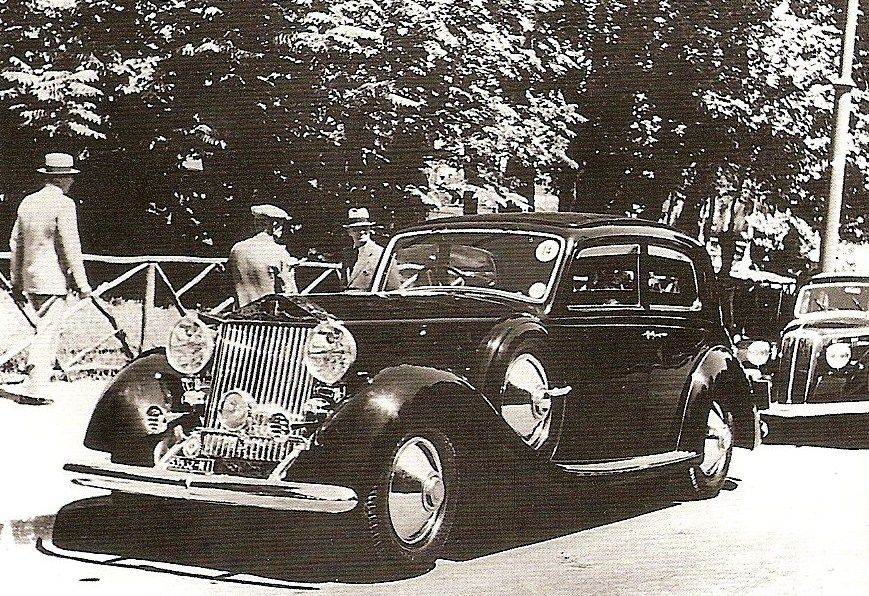
Unfortunately just as it was getting interesting (in design terms) WWII broke out and part way through, as we know Italy changed allegiance. Not only did they swap sides, they literally swapped sides in motoring terms and began driving on the right too. Anyway this as I said earlier caused a whole load of fuss directly after the war when they were banned from exhibiting their motorcars and coachwork. So going back to where we were a few posts back, I thought I would expand a little on the Facel Pininfarina deal with Rolls-Royce & Bentley motorcars.
Heres a picture of the Pininfarina Facel Cresta with before & after rework by Blatchley to the front end to explain in a picture what I’d only expressed in text previously.
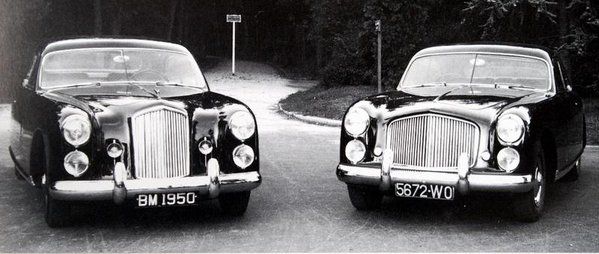
Facel took 17 or so MkVI Chassis to Pininfarina and had them bodied, Blatchley was employed by the factory to work with Pininfarina and “guide” them along the way.
This is where it all gets complicated again. The late 40’s was a very busy time for the Design Department. They’d begun working on the car that would become the Silver Cloud & Bentley SI, and with the ownership of Park Ward, Blatchley headed the team under Evernden that were developing a whole series of Park Ward (R-R Factory) Coachbuilt Continentals. John would tell me “We were all very busy, but seemed to be making no cars” such was his frustration at the time things were taking.
A special project with Mulliner (who were not yet owned by Rolls-Royce) in 1947-48 was also undertaken.
Rolls-Royce had invested heavily in the pressed steel panels for the MkVI and knew that traditional coachbuilt ash and aluminium bodies were time consuming and costly to build with also very little possibility of interchangeable panels between cars due to size differences; therefore resulting in little or no aftermarket parts support being possible.
Displeased with the finished weight of the Pininfarina body design, and Facel & Pininfarina unaware of the imminent loss of business, Rolls-Royce had turned to Mulliner who were working on a new method of light body construction that closer resembled aircraft than motorcar.
The first car a fastback was styled by Blatchleys team and light weight constructed by Mulliner
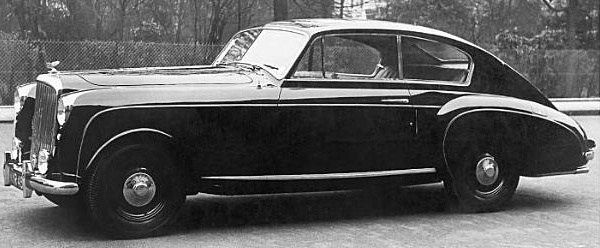
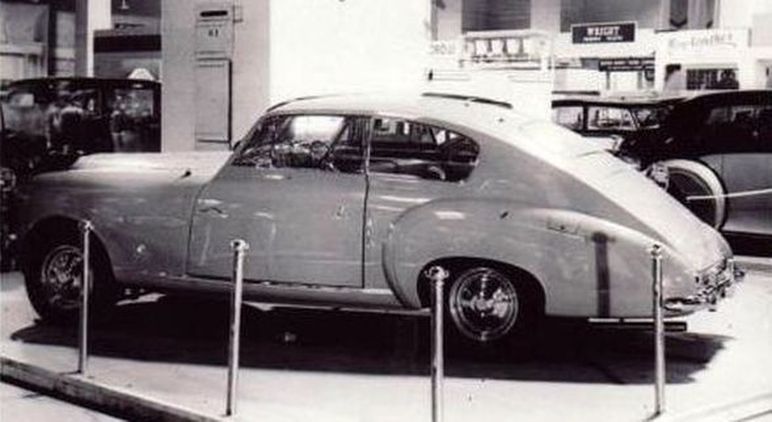
This obviously didn’t go down too well with Pininfarina. A year later they got a commission from Luigi Bressani of Milan who was a wealthy businessman and Rolls-Royce owner for a Silver Dawn Sports Coupe. At this time it was to be the most expensive car in the World (which was a feather in the cap for Pininfarina)
The car wasn’t completed until 1951 and exhibited at the Torino motor show that year. The car caused a storm and Rolls-Royce & Pininfarina were inundated with enquiries.
John was not so impressed “It was our design dressed up” he told me. “The only difference was the Cadillac signature front wings and the powers that be, bought into it. They even started negotiations with Pininfarina to mass produce it instead of our Park Ward Continental!”
However Pininfarina costs were too high and the idea was scrapped.
What is most interesting to me, and hopefully anyone reading this; is that following the success at Torino of this Pininfarina Rolls-Royce Silver Dawn, and potential contract, it tipped the balance and forced the hand of one Enzo Ferrari and he signed a contract there and then with Pininfarina. The rest is history!
The first is the fastback of Pininfarina (I’m going to say inspired rather than copied, but judge for yourself) Blatchley designs that sealed the Ferrari deal. (2nd & 3rd are expanded into a coupe & drophead Bentley)
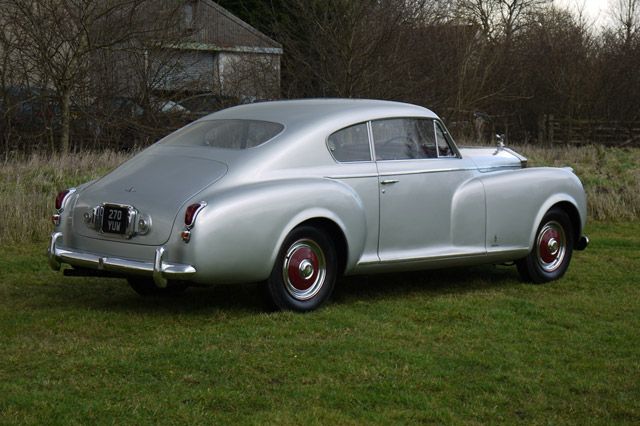
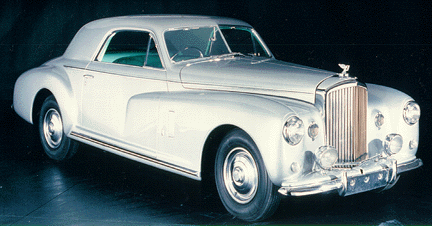
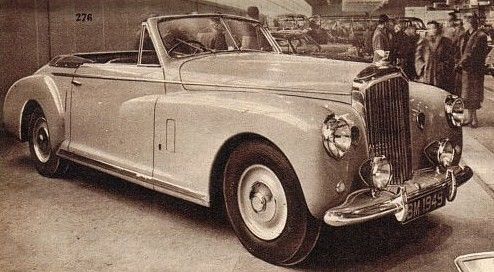
Now, if you’re following my ramblings, here’s something that shocked me when I came across it a few years ago after speaking with John.
Blatchley worked closely with Pininfarina, sharing ideas, following the introduction via Daninos at Facel. It was presumed that Pininfarina could possibly build the Mk VI replacement and the Cresta was the basis. I know there are doubters about the Jag XK120 origins and in particular the Bentley Blizzard design. Which came first and all that.
Well, a few years back this Pininfarina drawing purporting to 1947 saw the light of day and was part of a collection of Rolls-Royce Pininfarina drawings (like the one earlier in this thread)
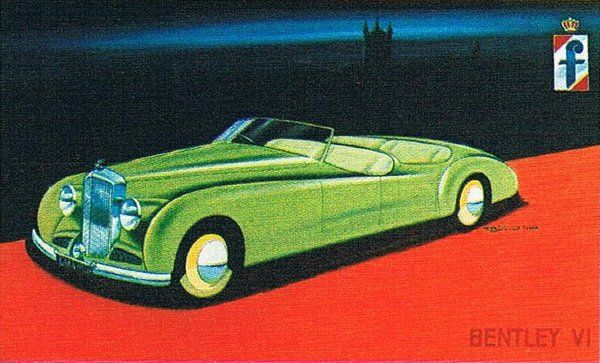
This is more than co-incidence. It is dated to when Blatchley was sharing information on Cresta……..At the time he thought his Blizzard design wouldn’t be built by R-R and before Jaguar had conceived the XK. Pininfarina could not have randomly come up with this design if they hadn't known about Blizzard, nothing is remotely Pininfarina style about it.
Very interesting……..this would not be the end of Pininfarina & Rolls-Royce's relationship just yet.
But not as interesting as the history bombs I have yet to drop that will challenge what we all think we know about VW and Porsche, and how Blatchley influenced them.
Anyway, I’ve found a copy of Johns Gurney Nutting Design (early cos its signed JB not JPB) that I believe was the basis for the Jag MkV, I hope you can see where I’m coming from.

So onto tonight’s twisting tale of intrigue.
Pre-war there were hundreds of Coachbuilders across the globe and a select few (mainly the good ones) got to body Rolls-Royce & Bentley Chassis. Last time I touched upon Germany, who I will end with this evening, but first lets look at Pininfarina
Pininfarina had a good working relationship with Rolls-Royce and had many Chassis delivered to them on behalf of wealthy Swiss, Italian and discerning Europeans.
They even produced design catalogues of Rolls-Royce & Bentley body designs.

In the 20’s and early 30’s they tended to be in keeping with general expectations of Rolls-Royce and although elegant, hadn’t found that Pininfarina identity yet as this Phantom shows.

In the mid 30’s they started to gain in confidence and the Pininfarina styling cues started to appear. You can see clearly in this 1937 the “italianization” of the sloping radiator.

Unfortunately just as it was getting interesting (in design terms) WWII broke out and part way through, as we know Italy changed allegiance. Not only did they swap sides, they literally swapped sides in motoring terms and began driving on the right too. Anyway this as I said earlier caused a whole load of fuss directly after the war when they were banned from exhibiting their motorcars and coachwork. So going back to where we were a few posts back, I thought I would expand a little on the Facel Pininfarina deal with Rolls-Royce & Bentley motorcars.
Heres a picture of the Pininfarina Facel Cresta with before & after rework by Blatchley to the front end to explain in a picture what I’d only expressed in text previously.

Facel took 17 or so MkVI Chassis to Pininfarina and had them bodied, Blatchley was employed by the factory to work with Pininfarina and “guide” them along the way.
This is where it all gets complicated again. The late 40’s was a very busy time for the Design Department. They’d begun working on the car that would become the Silver Cloud & Bentley SI, and with the ownership of Park Ward, Blatchley headed the team under Evernden that were developing a whole series of Park Ward (R-R Factory) Coachbuilt Continentals. John would tell me “We were all very busy, but seemed to be making no cars” such was his frustration at the time things were taking.
A special project with Mulliner (who were not yet owned by Rolls-Royce) in 1947-48 was also undertaken.
Rolls-Royce had invested heavily in the pressed steel panels for the MkVI and knew that traditional coachbuilt ash and aluminium bodies were time consuming and costly to build with also very little possibility of interchangeable panels between cars due to size differences; therefore resulting in little or no aftermarket parts support being possible.
Displeased with the finished weight of the Pininfarina body design, and Facel & Pininfarina unaware of the imminent loss of business, Rolls-Royce had turned to Mulliner who were working on a new method of light body construction that closer resembled aircraft than motorcar.
The first car a fastback was styled by Blatchleys team and light weight constructed by Mulliner


This obviously didn’t go down too well with Pininfarina. A year later they got a commission from Luigi Bressani of Milan who was a wealthy businessman and Rolls-Royce owner for a Silver Dawn Sports Coupe. At this time it was to be the most expensive car in the World (which was a feather in the cap for Pininfarina)
The car wasn’t completed until 1951 and exhibited at the Torino motor show that year. The car caused a storm and Rolls-Royce & Pininfarina were inundated with enquiries.
John was not so impressed “It was our design dressed up” he told me. “The only difference was the Cadillac signature front wings and the powers that be, bought into it. They even started negotiations with Pininfarina to mass produce it instead of our Park Ward Continental!”
However Pininfarina costs were too high and the idea was scrapped.
What is most interesting to me, and hopefully anyone reading this; is that following the success at Torino of this Pininfarina Rolls-Royce Silver Dawn, and potential contract, it tipped the balance and forced the hand of one Enzo Ferrari and he signed a contract there and then with Pininfarina. The rest is history!
The first is the fastback of Pininfarina (I’m going to say inspired rather than copied, but judge for yourself) Blatchley designs that sealed the Ferrari deal. (2nd & 3rd are expanded into a coupe & drophead Bentley)



Now, if you’re following my ramblings, here’s something that shocked me when I came across it a few years ago after speaking with John.
Blatchley worked closely with Pininfarina, sharing ideas, following the introduction via Daninos at Facel. It was presumed that Pininfarina could possibly build the Mk VI replacement and the Cresta was the basis. I know there are doubters about the Jag XK120 origins and in particular the Bentley Blizzard design. Which came first and all that.
Well, a few years back this Pininfarina drawing purporting to 1947 saw the light of day and was part of a collection of Rolls-Royce Pininfarina drawings (like the one earlier in this thread)

This is more than co-incidence. It is dated to when Blatchley was sharing information on Cresta……..At the time he thought his Blizzard design wouldn’t be built by R-R and before Jaguar had conceived the XK. Pininfarina could not have randomly come up with this design if they hadn't known about Blizzard, nothing is remotely Pininfarina style about it.
Very interesting……..this would not be the end of Pininfarina & Rolls-Royce's relationship just yet.
But not as interesting as the history bombs I have yet to drop that will challenge what we all think we know about VW and Porsche, and how Blatchley influenced them.
@classiccarguru1
Re: Rolls-Royce pre-eminent Aero Engine Maker and their cars
There was a lot going on at Rolls-Royce & Bentley during the late 1940’s. Even Mulliner were building Bentley MkVI “styled” bodies for Alvis.
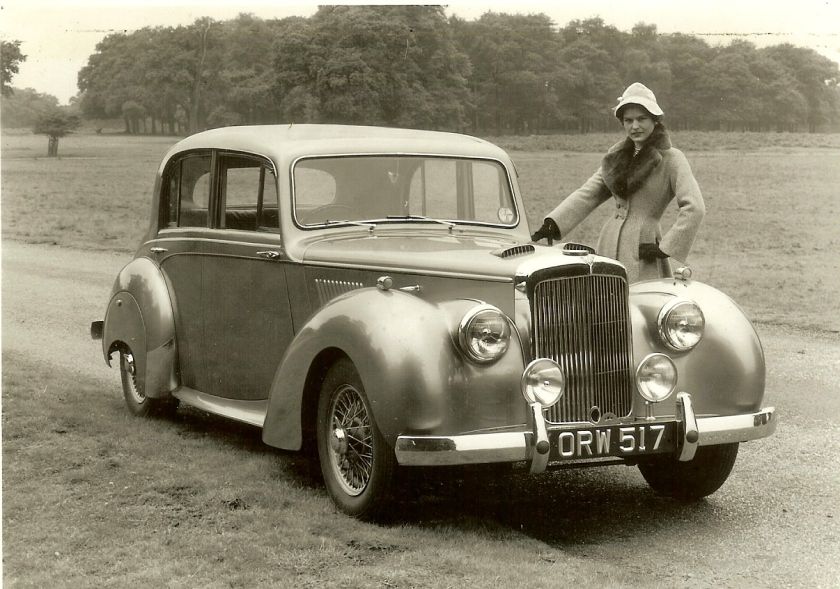
While Park Ward design department (under Blatchley) were busy evaluating prototype Karrosserie Herman Graber of Switzerland next generation Alvis coupe’s!
Evernden had been tasked to produce a Coachbuilt Bentley to build alongside the standard Bentley MkVI. Blatchley was employed as chief stylist. The brief was that it should follow in the footsteps of the 1938 4½ litre “Embricos” Bentley originally built in Paris, under the guidance of the Bentley Motors development engineers. The coachwork was designed by Georges Paulin and built by Van Vooren but without doubt drew inspiration from earlier Pininfarina Coachwork fitted to cars such as the Alfa Romeo 6C 2300 Pescara Berlinetta Aerodynamica. (I told you all this was intertwined!)
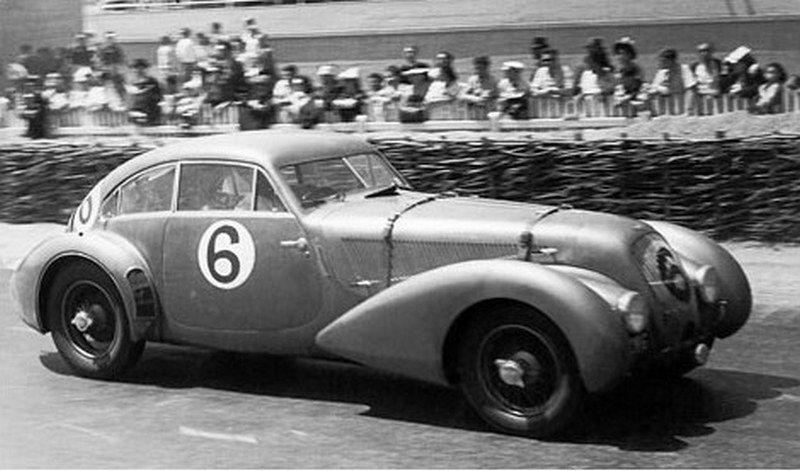
Anyway, the project was called Corniche but when launched in 1951 it had changed to R-Type Continental in reference to the modified Chassis it now resided on.
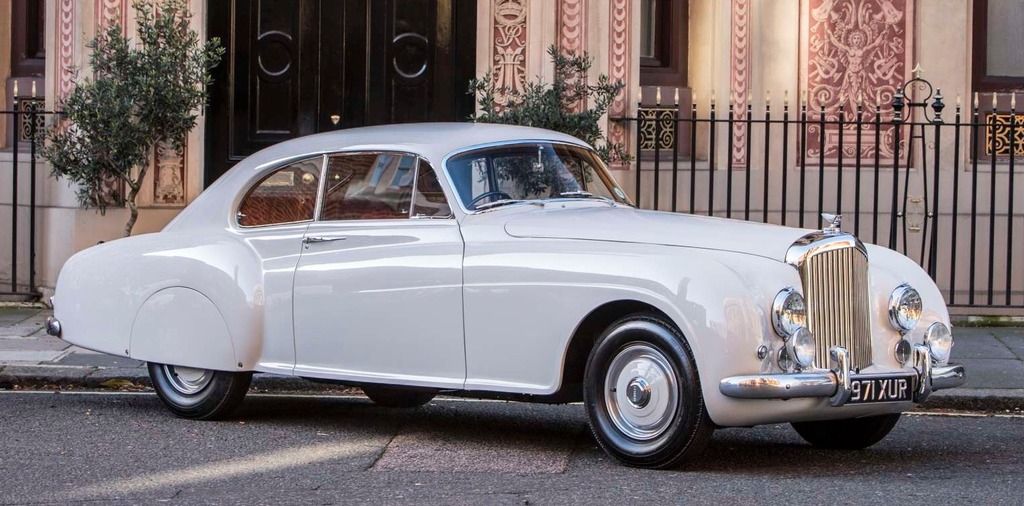
John Blatchley had the ability to take all the goodness from the recent Roll-Royce prototype designs and combine them to create a car that was simply stunning and elegant.
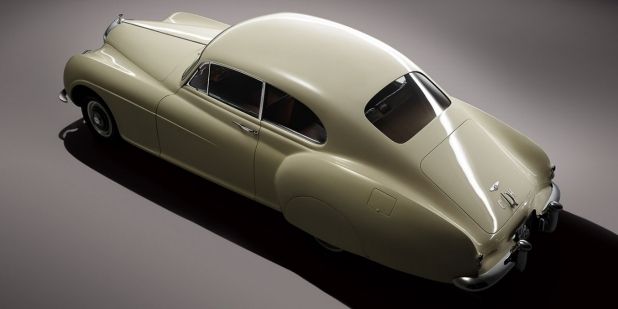
While all this was taking place, in 1951 Daninos of Facel was completing the last of the Bentley bodies for his wife. Named Cresta II, with the aid of Blatchley combining a roof design from Stabilimenti Farina (From the Facel - Simca Stabilimenti Farina cars) the result was another stunning Bentley.

I asked John about Facel & the Cresta II on one of my visits.
“A beautiful car and I can’t help thinking it inspired the VW Karmann Ghia“ I commented.
“Oh, yes” was Johns reply. “But why wouldn’t it?”
I wasn’t sure where this was going, as by now I knew with John, it would lead to some parallel dimension in automotive history.
“Johannes Beeskow always admired my work” John said in a matter of fact way.
“Beeskow!, how do you know Beeskow?” I asked from the edge of my seat.
Beeskow was chief engineer/designer at the German coachbuilder Rometsch and had designed some amazing early VW’s and Borgward’s.
Probably the Beeskow design that’ll interest DDK members the most is….
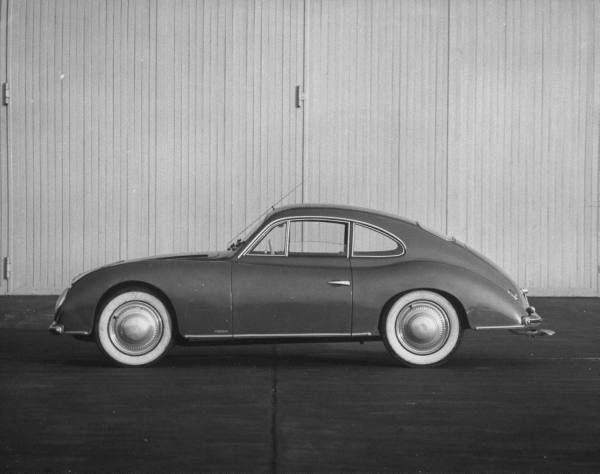
Beeskow stayed with Rometsch until early-mid 1950’s when he left to become Karmann's technical manager.
“How do you know Beeskow?”
“We were good friends for years” John replied.
“From Erdmann & Rossi, he regularly came to visit me at Gurney Nutting with the Peters Brothers. Nice chap, very keen and admired my work, he had great potential and I saw that in him. Just needed pointing in the right directions”
“I never knew he worked for Erdmann & Rossi? So he worked with all your original designs and drawings?”
“Oh, yes, he studied them intensely and incorporated them into projects they did, not just the Rolls & Bentley’s”
“So he was involved in the project Streamline too?”
“Of course”
Beeskow stayed with Erdmann & Rossi until the start of the war and afterwards joined Rometsch, while continuing contact with Blatchley.
Here’s a tantalising Karmann VW prototype (possibly the car that inspired the Karmann Ghia side profile maybe…who knows) it appears to have taken its styling from the XK120, or is that the Blizzard, or perhaps the Erdmann & Rossi Opel or maybe, just maybe the Gurney Nutting Streamline!
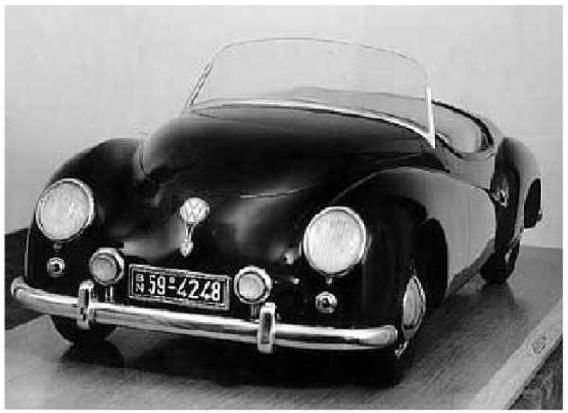
I was keen to ask John more about Beeskow…..

While Park Ward design department (under Blatchley) were busy evaluating prototype Karrosserie Herman Graber of Switzerland next generation Alvis coupe’s!
Evernden had been tasked to produce a Coachbuilt Bentley to build alongside the standard Bentley MkVI. Blatchley was employed as chief stylist. The brief was that it should follow in the footsteps of the 1938 4½ litre “Embricos” Bentley originally built in Paris, under the guidance of the Bentley Motors development engineers. The coachwork was designed by Georges Paulin and built by Van Vooren but without doubt drew inspiration from earlier Pininfarina Coachwork fitted to cars such as the Alfa Romeo 6C 2300 Pescara Berlinetta Aerodynamica. (I told you all this was intertwined!)

Anyway, the project was called Corniche but when launched in 1951 it had changed to R-Type Continental in reference to the modified Chassis it now resided on.

John Blatchley had the ability to take all the goodness from the recent Roll-Royce prototype designs and combine them to create a car that was simply stunning and elegant.

While all this was taking place, in 1951 Daninos of Facel was completing the last of the Bentley bodies for his wife. Named Cresta II, with the aid of Blatchley combining a roof design from Stabilimenti Farina (From the Facel - Simca Stabilimenti Farina cars) the result was another stunning Bentley.

I asked John about Facel & the Cresta II on one of my visits.
“A beautiful car and I can’t help thinking it inspired the VW Karmann Ghia“ I commented.
“Oh, yes” was Johns reply. “But why wouldn’t it?”
I wasn’t sure where this was going, as by now I knew with John, it would lead to some parallel dimension in automotive history.
“Johannes Beeskow always admired my work” John said in a matter of fact way.
“Beeskow!, how do you know Beeskow?” I asked from the edge of my seat.
Beeskow was chief engineer/designer at the German coachbuilder Rometsch and had designed some amazing early VW’s and Borgward’s.
Probably the Beeskow design that’ll interest DDK members the most is….

Beeskow stayed with Rometsch until early-mid 1950’s when he left to become Karmann's technical manager.
“How do you know Beeskow?”
“We were good friends for years” John replied.
“From Erdmann & Rossi, he regularly came to visit me at Gurney Nutting with the Peters Brothers. Nice chap, very keen and admired my work, he had great potential and I saw that in him. Just needed pointing in the right directions”
“I never knew he worked for Erdmann & Rossi? So he worked with all your original designs and drawings?”
“Oh, yes, he studied them intensely and incorporated them into projects they did, not just the Rolls & Bentley’s”
“So he was involved in the project Streamline too?”
“Of course”
Beeskow stayed with Erdmann & Rossi until the start of the war and afterwards joined Rometsch, while continuing contact with Blatchley.
Here’s a tantalising Karmann VW prototype (possibly the car that inspired the Karmann Ghia side profile maybe…who knows) it appears to have taken its styling from the XK120, or is that the Blizzard, or perhaps the Erdmann & Rossi Opel or maybe, just maybe the Gurney Nutting Streamline!

I was keen to ask John more about Beeskow…..
@classiccarguru1
Re: Rolls-Royce pre-eminent Aero Engine Maker and their cars
The R-Type and Silver Dawn were only a stop-gap to the car that Blatchley & his team had been working on. Originally the Bentley MkVIII, it became the Mk IX and then Project Siam; things were taking a long time without a car making it into production. I asked John why this was.
Looking at another drawing he’d taken from the drawer, John replied…
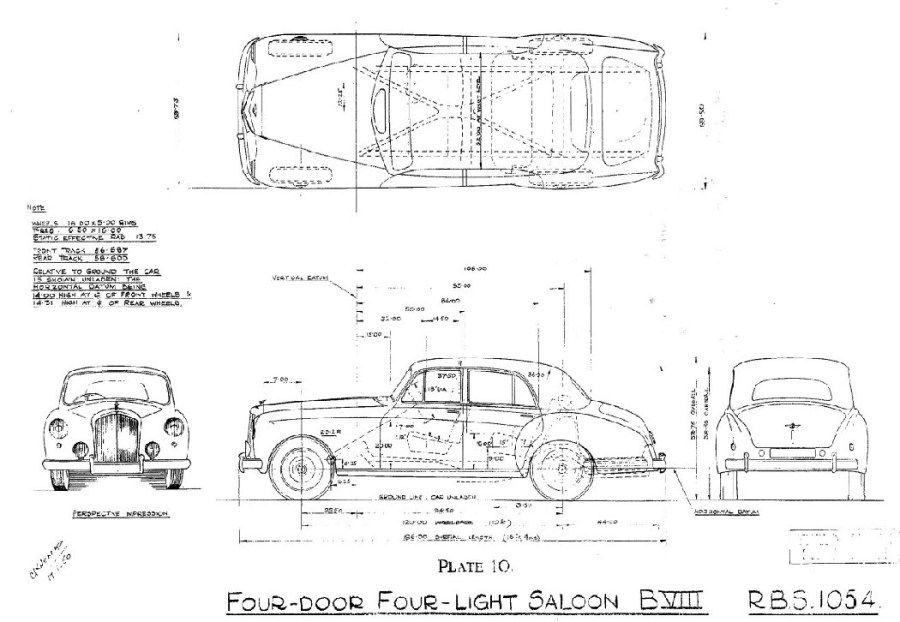
"I spent years working on one full-size mock-up of 'the new car' only to be told when it was finished to burn it" he said.
“Why would they tell you to do that?”
“It was too modern” he said with despair. Considering this was John’s forte (to design years ahead) it must have been a bitter pill to take.
“I did a quick sketch combining the old MkVI front, lost the smooth styling of the sides in favour of the old Blizzard and added a version of the new rear end; took me about 10 minutes in all. They rushed it into the Boardroom” He said. “I couldn’t believe it, they loved it!”
The Silver Cloud and Bentley SI was born.
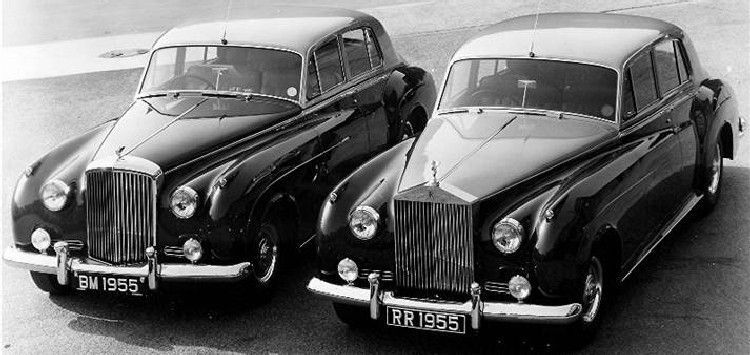
It was to be the car that Blatchley is best remembered, which is ironic as he designed it in the shortest time and in my opinion it isn’t his most elegant car. Based on a new separate chassis and with a new drive-train the two pressed steel models arrived in early 1955 and ran until 1966. Again there was lots of mechanical advances in these cars, but I’m concentrating more on the design here.
Small changes were made over the production run producing the SII & Cloud II
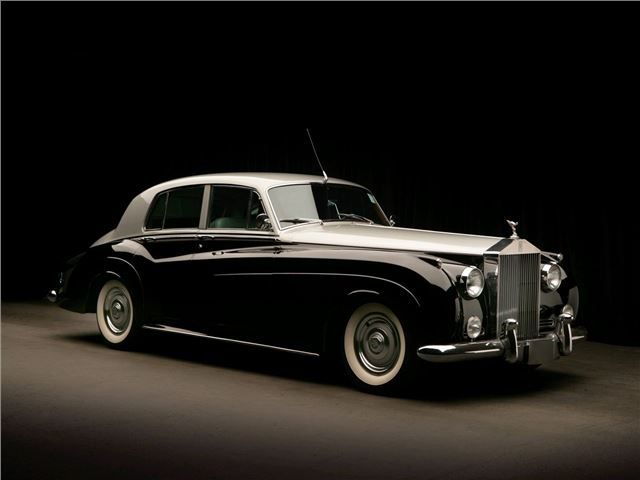
The equivalent coachbuilt Drophead
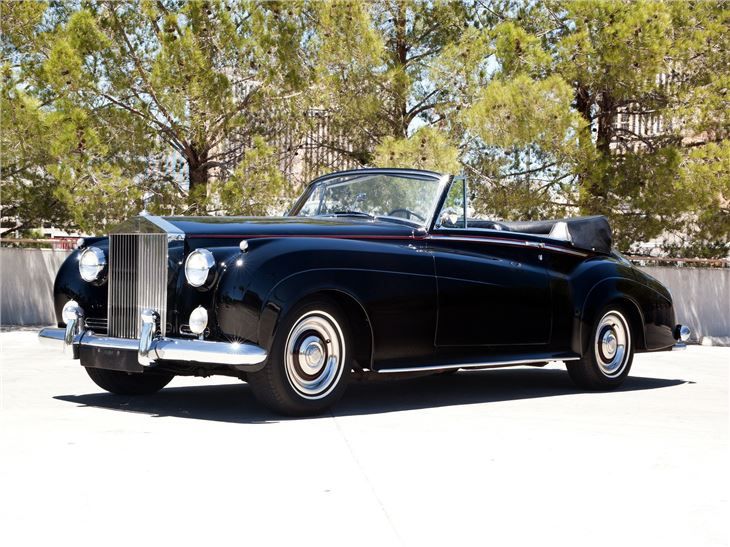
Ending with the S3 & Cloud III, with its distinctive twin horizontal headlights.
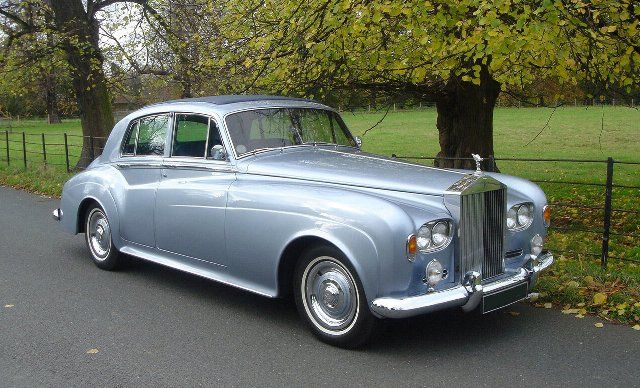
With a Drophead version.
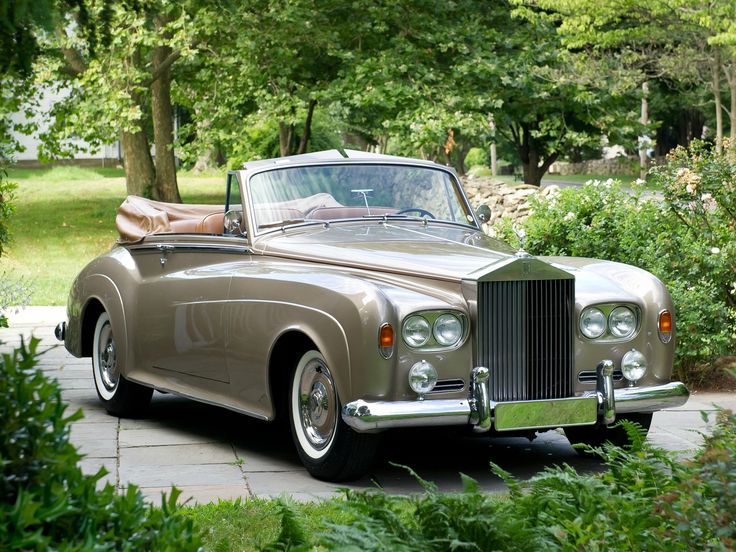
Throught Cloud and Bentley S series production, customers could still purchase the coachbuilt Continentals, which evolved alongside the standard pressed steel cars.
I can’t help but think this was inspired by the Blatchey/Farina/Facel Cresta II of Mrs Daninos

A 4 door version was also available.

Meanwhile Beeskow was at Karmann and the Ghia was well underway.
“Looking at the Cloud John, I can see the swage wing-line was put back into the sides of the car when you wanted it slab sided?” I asked to confirm what I thought he’d said earlier was correct.
“Oh yes. The design looked old fashioned, but that’s what they wanted. It looked better on smaller cars at the time, not a Rolls-Royce” he replied.
“Like the Karmann Ghia?” I asked.
“Yes Johannes was good at taking big car styling and incorporating it into smaller cars without loosing the elegance. He did it so well at Erdmann & Rossi. We were about the same age you know, we liked the same things.”
Looking at another drawing he’d taken from the drawer, John replied…

"I spent years working on one full-size mock-up of 'the new car' only to be told when it was finished to burn it" he said.
“Why would they tell you to do that?”
“It was too modern” he said with despair. Considering this was John’s forte (to design years ahead) it must have been a bitter pill to take.
“I did a quick sketch combining the old MkVI front, lost the smooth styling of the sides in favour of the old Blizzard and added a version of the new rear end; took me about 10 minutes in all. They rushed it into the Boardroom” He said. “I couldn’t believe it, they loved it!”
The Silver Cloud and Bentley SI was born.

It was to be the car that Blatchley is best remembered, which is ironic as he designed it in the shortest time and in my opinion it isn’t his most elegant car. Based on a new separate chassis and with a new drive-train the two pressed steel models arrived in early 1955 and ran until 1966. Again there was lots of mechanical advances in these cars, but I’m concentrating more on the design here.
Small changes were made over the production run producing the SII & Cloud II

The equivalent coachbuilt Drophead

Ending with the S3 & Cloud III, with its distinctive twin horizontal headlights.

With a Drophead version.

Throught Cloud and Bentley S series production, customers could still purchase the coachbuilt Continentals, which evolved alongside the standard pressed steel cars.
I can’t help but think this was inspired by the Blatchey/Farina/Facel Cresta II of Mrs Daninos

A 4 door version was also available.

Meanwhile Beeskow was at Karmann and the Ghia was well underway.
“Looking at the Cloud John, I can see the swage wing-line was put back into the sides of the car when you wanted it slab sided?” I asked to confirm what I thought he’d said earlier was correct.
“Oh yes. The design looked old fashioned, but that’s what they wanted. It looked better on smaller cars at the time, not a Rolls-Royce” he replied.
“Like the Karmann Ghia?” I asked.
“Yes Johannes was good at taking big car styling and incorporating it into smaller cars without loosing the elegance. He did it so well at Erdmann & Rossi. We were about the same age you know, we liked the same things.”
@classiccarguru1
Re: Rolls-Royce pre-eminent Aero Engine Maker and their cars
I mentioned earlier that John Blatchley had a lot going on in the late 1940’s into the early 1950’s. His designs filtered throughout British Car Manufacture, directly and indirectly yet he is little known. Much like Erwin Komenda who was body shape designer of the Beetle, 356, 911, 904 and even the Porsche crest (not Ferdinand or Butzi) their work is unacknowledged by history while others take the credit. (But that’s a whole other story for another thread) 
Alvis is a good example of his little known or recognised influence. John designed a good number of Alvis bodies while at Gurney Nutting before the war including this Alvis Coupe
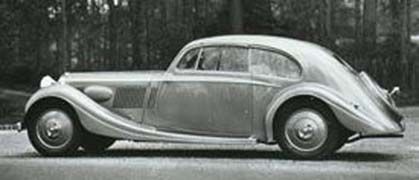
With a Gurney Nutting 4 door saloon Alvis design.

The finished car
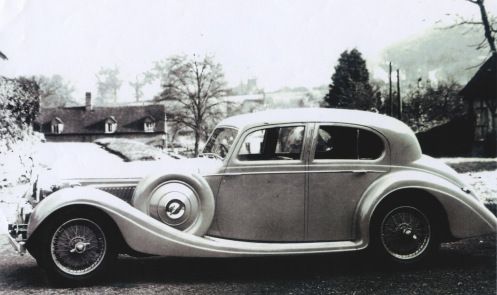
Following the war, the Alvis Grey Lady (as in my previous post) was again a version of the Bentley MkVI.
During the development of the Rolls-Royce Silver Cloud and Continental designs, the evolution of the Abbott bodied Farnham and Estoril was code named Corniche II. Another Blatchley design team effort around 1948.
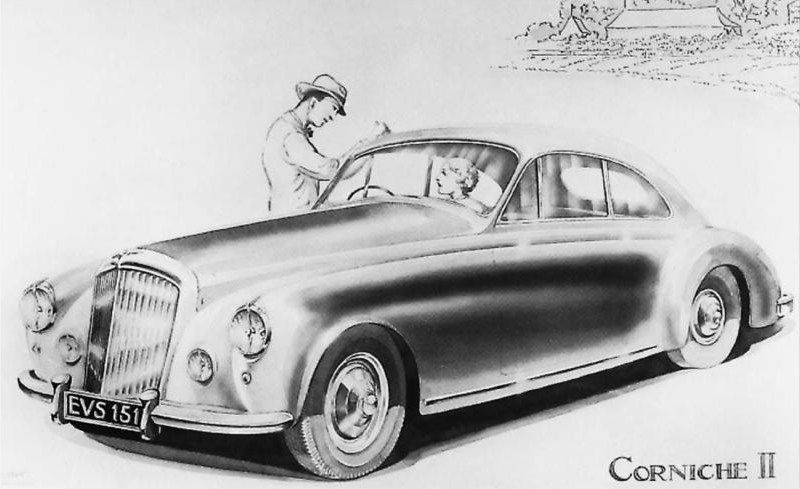
Never put into production by R-R as considered in 1948, to be “too modern” it sat in Blatchleys back catalogue.
Alvis were having their bodies built by Mulliners (Birmingham), but in 1955 things started to go a little wrong at Mulliners. With new pressed steel mass produced bodied cars becoming cheaper and therefore more popular, they were finding it hard building handbuilt cars In 1955 Mulliners coachwork announced they would no longer continue production.
Standard-Triumph stepped in and took much of Mulliner’s production capacity and wanted Mulliners for their new Triumph Herald. The deal was done and Standard-Triumph bought Mulliners. Alvis had lost their coachbuilder and took their next generation of designs (which I believe Blatchley had a hand in) to Graber of Switzerland. Interesting choice for a British company? I can’t help but think there was some link here with Blatchley, Daninos and his use of Graber for some styling of the Cresta II Bentley as they all worked together and Blatchley was busy between Crewe & Park Ward.
After Graber’s produced a prototype for Alvis they were unable to mass produce even in low volume at their small factory, preferring individual one-off commissions. Alvis were stuck again and turned to coachbuilders Willowbrook of Loughborough. Graber wanted payment of licensing and royalties, so eventually Alvis went back to Blatchley and Park Ward to re-style the car.
The resulting mid 50’s Alvis looks remarkably like the 1948 Corniche II design!

With production now at Park Ward, Blatchley had a further hand in the evolution of Alvis
His influences are clear in later models as they mirrored his Rolls-Royce & Bentley Park Ward Continentals.
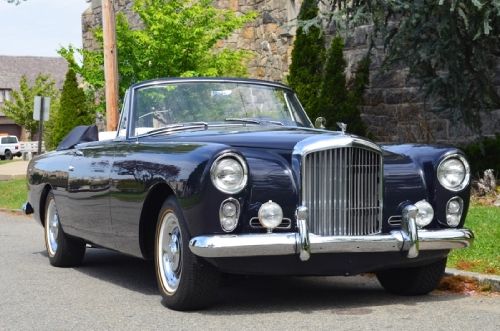
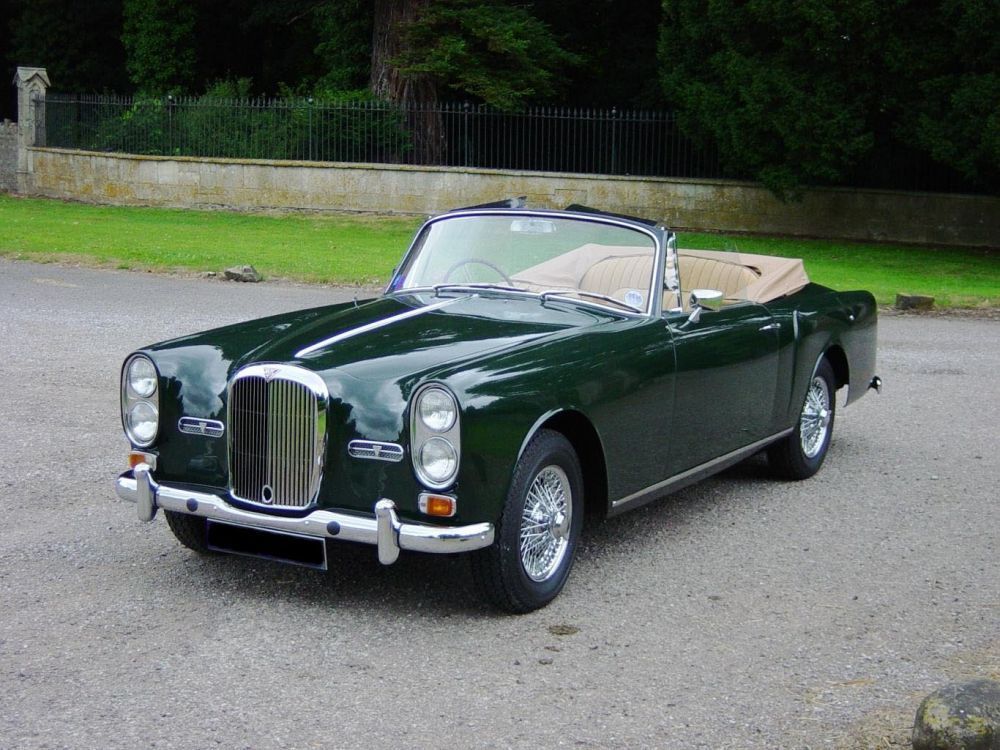
Blatchley was continuously playing with lights. Vertical & Horizontal, twin lights and even angled them to create the Chinese Eye. Here in Rolls-Royce form.
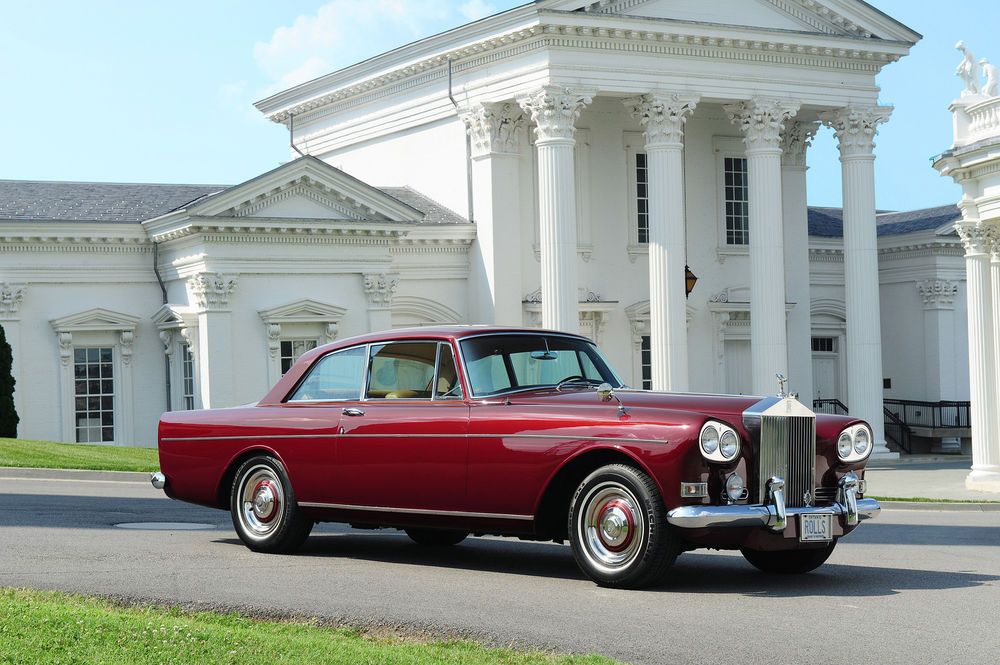
And as a Bentley.
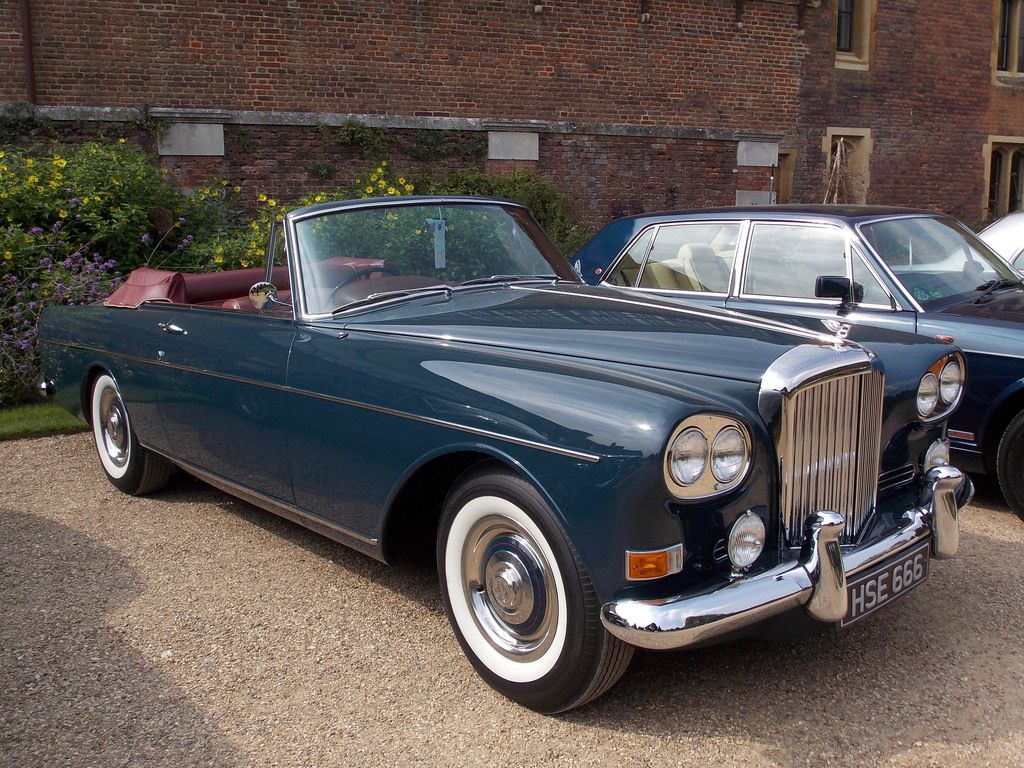
It is also worth noting that the cars flanks were showing less of the prominent contoured signatures of pre-war wings that John had wanted way back in the late 1940’s and had been told to “throw on the fire” as it was too modern. It took 15 years, the Alvis, the purchase of H.J.Mulliner in 1959 and slowly, slowly introducing the idea into the Continentals for his modernist designs to be accepted at Rolls-Royce.
Meanwhile as another “coincidence” or twist in the XK120 story, depending how you look at it. Following the tantalizing Pininfarina 4 seater design I posted previously; in 1951 a “one-off” coachbuilt 4 seater Jaguar XK120 was made. Out of many, many coachbuilders it was by none other than Abbott of Farnham, the chosen builder of Blatchley’s prototype Rolls-Royce designs.
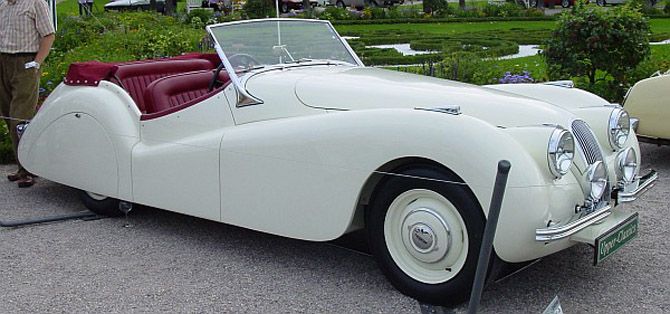
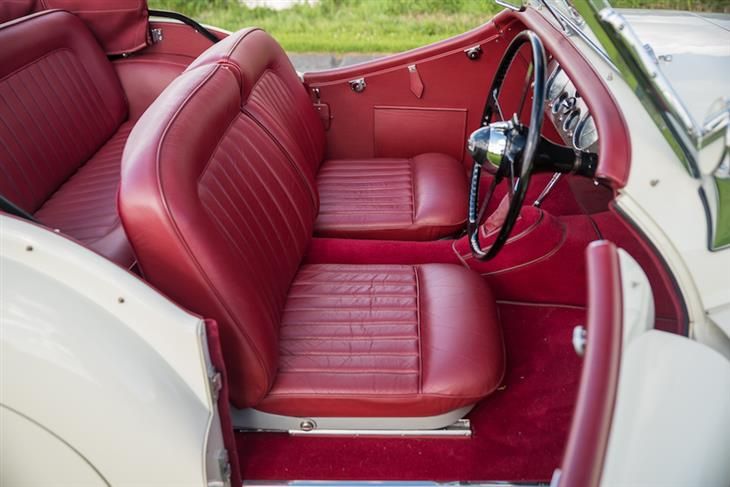
Truth is often stranger than fiction.
Alvis is a good example of his little known or recognised influence. John designed a good number of Alvis bodies while at Gurney Nutting before the war including this Alvis Coupe

With a Gurney Nutting 4 door saloon Alvis design.

The finished car

Following the war, the Alvis Grey Lady (as in my previous post) was again a version of the Bentley MkVI.
During the development of the Rolls-Royce Silver Cloud and Continental designs, the evolution of the Abbott bodied Farnham and Estoril was code named Corniche II. Another Blatchley design team effort around 1948.

Never put into production by R-R as considered in 1948, to be “too modern” it sat in Blatchleys back catalogue.
Alvis were having their bodies built by Mulliners (Birmingham), but in 1955 things started to go a little wrong at Mulliners. With new pressed steel mass produced bodied cars becoming cheaper and therefore more popular, they were finding it hard building handbuilt cars In 1955 Mulliners coachwork announced they would no longer continue production.
Standard-Triumph stepped in and took much of Mulliner’s production capacity and wanted Mulliners for their new Triumph Herald. The deal was done and Standard-Triumph bought Mulliners. Alvis had lost their coachbuilder and took their next generation of designs (which I believe Blatchley had a hand in) to Graber of Switzerland. Interesting choice for a British company? I can’t help but think there was some link here with Blatchley, Daninos and his use of Graber for some styling of the Cresta II Bentley as they all worked together and Blatchley was busy between Crewe & Park Ward.
After Graber’s produced a prototype for Alvis they were unable to mass produce even in low volume at their small factory, preferring individual one-off commissions. Alvis were stuck again and turned to coachbuilders Willowbrook of Loughborough. Graber wanted payment of licensing and royalties, so eventually Alvis went back to Blatchley and Park Ward to re-style the car.
The resulting mid 50’s Alvis looks remarkably like the 1948 Corniche II design!

With production now at Park Ward, Blatchley had a further hand in the evolution of Alvis
His influences are clear in later models as they mirrored his Rolls-Royce & Bentley Park Ward Continentals.


Blatchley was continuously playing with lights. Vertical & Horizontal, twin lights and even angled them to create the Chinese Eye. Here in Rolls-Royce form.

And as a Bentley.

It is also worth noting that the cars flanks were showing less of the prominent contoured signatures of pre-war wings that John had wanted way back in the late 1940’s and had been told to “throw on the fire” as it was too modern. It took 15 years, the Alvis, the purchase of H.J.Mulliner in 1959 and slowly, slowly introducing the idea into the Continentals for his modernist designs to be accepted at Rolls-Royce.
Meanwhile as another “coincidence” or twist in the XK120 story, depending how you look at it. Following the tantalizing Pininfarina 4 seater design I posted previously; in 1951 a “one-off” coachbuilt 4 seater Jaguar XK120 was made. Out of many, many coachbuilders it was by none other than Abbott of Farnham, the chosen builder of Blatchley’s prototype Rolls-Royce designs.


Truth is often stranger than fiction.
@classiccarguru1
Re: Rolls-Royce pre-eminent Aero Engine Maker and their cars
Before we move on through further developments of Rolls-Royce Motorcars, it is important to mention the Phantom. Originally introduced in 1925 as a replacement for the Silver Ghost, the Phantom I (1925-1931) was the choice of the World’s Royalty and most wealthy. It continued to evolve as Phantom II from 1929-1936 and as Phantom III from 1936-1939 incorporating the new V12 engine. Since this was the golden age of the coachbuilder, numerous lavish bodies and styles were placed on the Derby built chassis. As with other coachbuilders, Gurney Nutting adapter their entire catalogue with the aid of McNeil & Blatchley to clothe these large chassis. A good proportion of these cars had bespoke one-off designs and no two cars were ever alike. I’ve posted a few Phantom pictures previously and want to pick up in the current timeline of my story, so I won’t dwell on the pre-war Phantoms this evening as it is a massive subject.
But before we leave the Phantom III behind, here’s probably the most “famous” Phantom III.
https://www.youtube.com/watch?v=65nNcNiwJHM
Post war, times were changing and Rolls-Royce held back on Phantom production at Crewe until 1950
The Phantom IV was introduced in 1950 and ran until 1956. Only 18 Chassis were made, 9 of which were bodied by H.J.Mulliner
The first Phantom IV was built in 1949 for HM Queen Elizabeth & Prince Phillip. The driving position was built to the exacting sizes of the Duke of Edinburgh! The car (identical to below) is currently preferred transport of Prince Charles & Camilla.
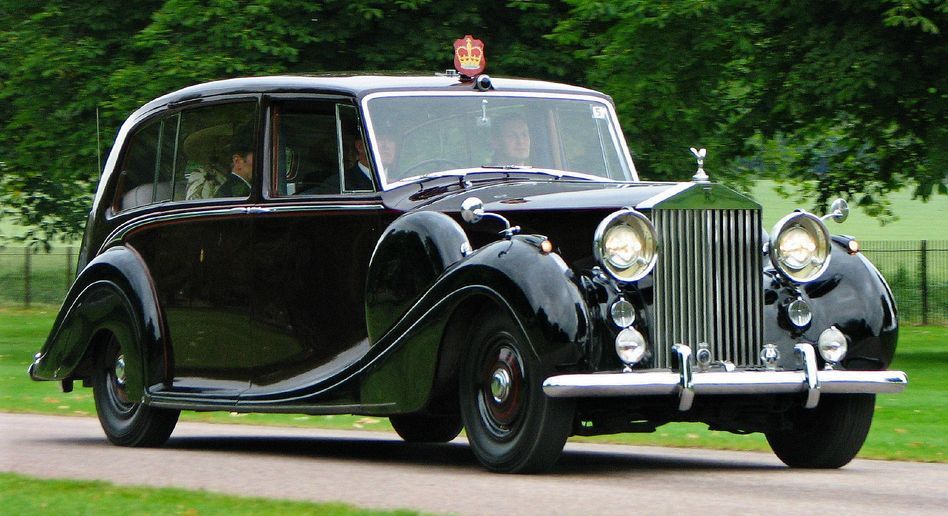
I asked John about it.
“Royal cars were some of my favourite cars” he said. “There was obviously great pressure on us to deliver a car that met with the expectation”.
“So did you succeed?”
“Mostly” John replied. “Sometimes a look said it all, other times certain things needed reworking, but we mostly got it right”.
The Phantom IV model was the last limitless design possibility car. Sold as a Chassis only, the bodies of the 18 cars built echoed a bygone age of ostentation.
From our own Queen to the Saudi Royal Prince Talal bin Abdulaziz Al Saud car…
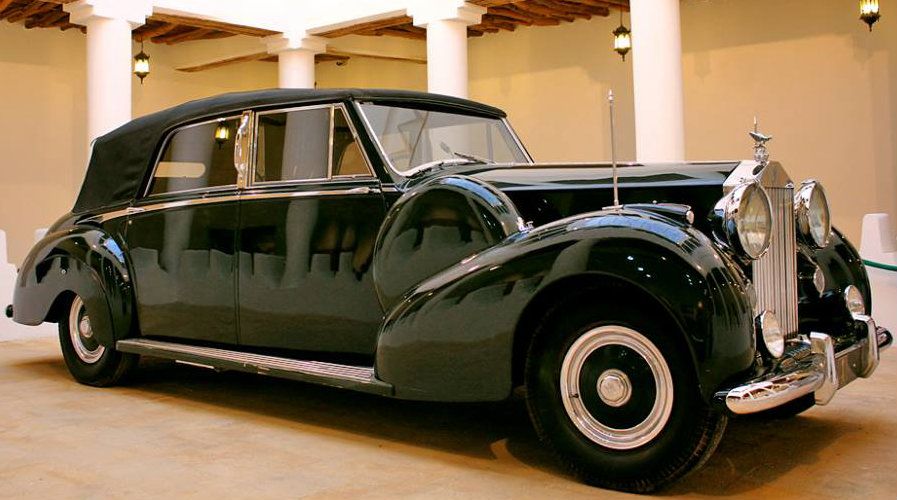
The Shah of Persia…

And the Aga Khan’s Phantom IV
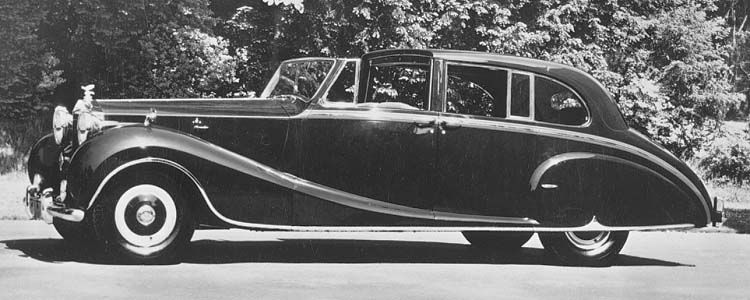
Blatchley, now head of styling for Park Ward began work on project ‘Aspidistra’ straight away. Rolls-Royce wanted to keep the Phantom bodywork in house. Aspidistra became the Phantom V.
The Phantom V. 1959-1968 (516 made)
John Blatchley joined by Bill Allen and Miss Cecily Jenner worked on the design of Project Aspidistra.
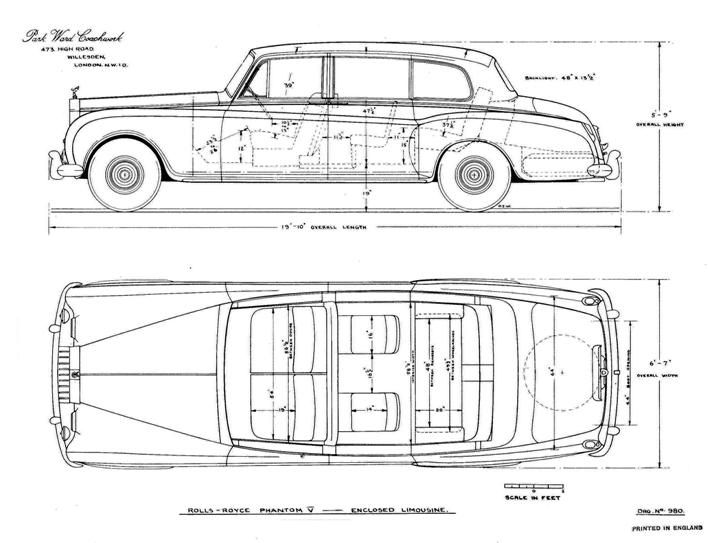
Blatchley working on the clay model

Interior designs for approval (From H.J.Mulliner)

Blatchley, Allen and Miss Jenner, with Aspidistra centre and other Park Ward designs discussed previously surrounding them.

The Phantom V was launched in 1959 as Rolls-Royce purchased H. J. Mulliners to create Mulliner-Park-Ward (MPW) It became an immediate hit with Royalty and World State

As a point of interest, James Young Coachbuilders led by A.F.McNeil (Blatchley’s friend and mentor from early Gurney Nutting days) produced their body version of the Phantom V which looked more in keeping with the Silver Cloud, than a separate model.

Phantom VI. 1968-1990 (374 made)
The Phantom VI was introduced in 1968 remaining in production for 23 years and visually wasn’t much different to the Phantom V. In 1979, the 6.2 V8 engine was enlarged to 6.75 with a completely restyled interior.
It is noteworthy that the Phantom VI was the last body-on-frame traditional construction Rolls-Royce.
As you can imagine there were numerous interesting examples
Project Canberra design

Canberra carrying Kate to her wedding with Prince William
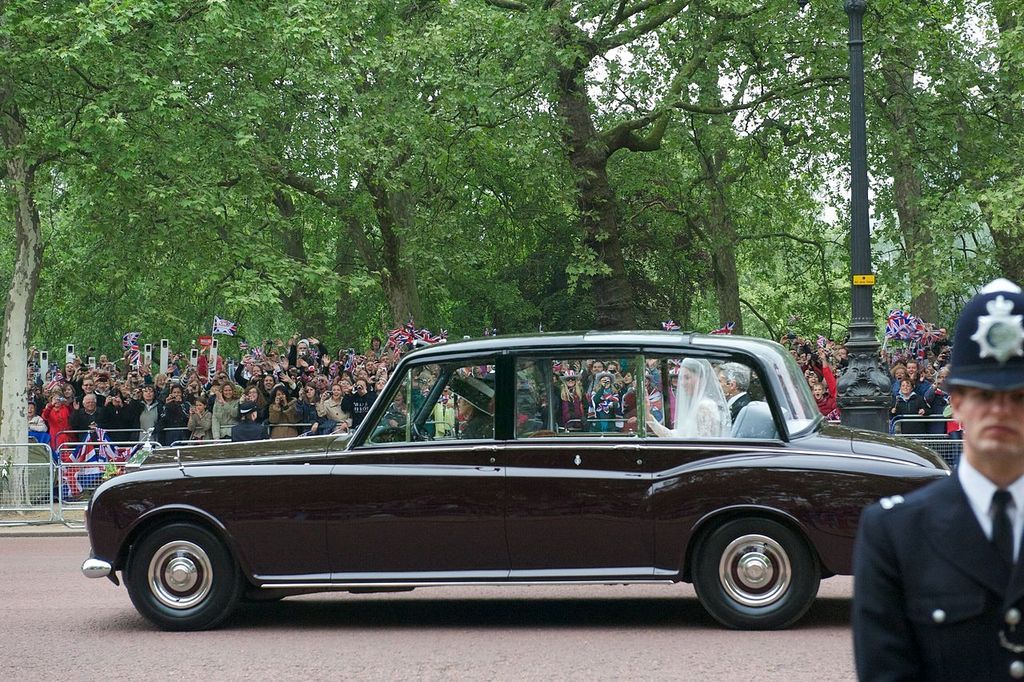
Besides the Goldfinger and Royal Phantoms there are also a few memorable cars for various reasons…
A favourite mode of transport for the Fab Four was a Rolls Royce Phantom. Here’s a picture of the group with their Phantom VI

You get a real feel for the size of these cars from that picture.
There was one special Beatle Phantom that caused a stir.
On June 3, 1965, a brand new Rolls-Royce Phantom V was delivered to John Lennon at his house near Weybridge. The Phantom V model had been fitted with a limousine body, finished in Valentines black with the registration FJB111C. He’d just passed his driving test! It wasn’t his first car however, that was a Ferrari 330GT Series I, which between the two created a recipe for disaster for someone who learned to drive a little late in life.
In 1966, Lennon had the back seat of the Phantom fitted with a double bed, TV, fridge and telephone. Music was provided by a state of the art vinyl record player with additional outside speaker system. The car was the first Rolls-Royce to have privacy glass.
It was said that Ringo Starr suggested to John that he should have the car painted in psychedelic colours. Lennon agreed and painted the car to match gypsy caravans. It caused quite a stir, including Lennon being beaten with an umbrella by a woman shouting, “You swine! You swine! How dare you do that to a Rolls-Royce!"
Lennon kept the Phantom and when he moved to the USA had it shipped over. Here’s a photo of the car with John and his son Julian.

Blatchley was involved with almost every Phantom built up to his departure in 1969 designing bespoke interiors, fittings and accessories. I spent a whole afternoon speaking with him about the Royal & State cars, the special features and even armour plating. Mostly confidential stuff I would have to kill you if I told you about.
One thing he did discuss was the mascot on the Queens Phantom IV (now Charles & Camilla’s) It isn’t a spirit of ecstasy, it’s a solid silver St George with Dragon.
“During the bump tests we broke the blessed thing” John told me.
“What, the Queens special mascot?”
“Yes, part of the Dragons jaw. We had to quickly redesign it so the tongue and jaw were better supported” he explained.
“Well, if its any consolation John, when I was in the Navy I flooded the Queens day room with stagnant seawater onboard the Yacht Britannia when I was working on a fire pump, ruined the very, very, VERY expensive carpet” I replied.
We spent that afternoon laughing and sharing stories.
But before we leave the Phantom III behind, here’s probably the most “famous” Phantom III.
https://www.youtube.com/watch?v=65nNcNiwJHM
Post war, times were changing and Rolls-Royce held back on Phantom production at Crewe until 1950
The Phantom IV was introduced in 1950 and ran until 1956. Only 18 Chassis were made, 9 of which were bodied by H.J.Mulliner
The first Phantom IV was built in 1949 for HM Queen Elizabeth & Prince Phillip. The driving position was built to the exacting sizes of the Duke of Edinburgh! The car (identical to below) is currently preferred transport of Prince Charles & Camilla.

I asked John about it.
“Royal cars were some of my favourite cars” he said. “There was obviously great pressure on us to deliver a car that met with the expectation”.
“So did you succeed?”
“Mostly” John replied. “Sometimes a look said it all, other times certain things needed reworking, but we mostly got it right”.
The Phantom IV model was the last limitless design possibility car. Sold as a Chassis only, the bodies of the 18 cars built echoed a bygone age of ostentation.
From our own Queen to the Saudi Royal Prince Talal bin Abdulaziz Al Saud car…

The Shah of Persia…

And the Aga Khan’s Phantom IV

Blatchley, now head of styling for Park Ward began work on project ‘Aspidistra’ straight away. Rolls-Royce wanted to keep the Phantom bodywork in house. Aspidistra became the Phantom V.
The Phantom V. 1959-1968 (516 made)
John Blatchley joined by Bill Allen and Miss Cecily Jenner worked on the design of Project Aspidistra.

Blatchley working on the clay model

Interior designs for approval (From H.J.Mulliner)

Blatchley, Allen and Miss Jenner, with Aspidistra centre and other Park Ward designs discussed previously surrounding them.

The Phantom V was launched in 1959 as Rolls-Royce purchased H. J. Mulliners to create Mulliner-Park-Ward (MPW) It became an immediate hit with Royalty and World State

As a point of interest, James Young Coachbuilders led by A.F.McNeil (Blatchley’s friend and mentor from early Gurney Nutting days) produced their body version of the Phantom V which looked more in keeping with the Silver Cloud, than a separate model.

Phantom VI. 1968-1990 (374 made)
The Phantom VI was introduced in 1968 remaining in production for 23 years and visually wasn’t much different to the Phantom V. In 1979, the 6.2 V8 engine was enlarged to 6.75 with a completely restyled interior.
It is noteworthy that the Phantom VI was the last body-on-frame traditional construction Rolls-Royce.
As you can imagine there were numerous interesting examples
Project Canberra design

Canberra carrying Kate to her wedding with Prince William

Besides the Goldfinger and Royal Phantoms there are also a few memorable cars for various reasons…
A favourite mode of transport for the Fab Four was a Rolls Royce Phantom. Here’s a picture of the group with their Phantom VI

You get a real feel for the size of these cars from that picture.
There was one special Beatle Phantom that caused a stir.
On June 3, 1965, a brand new Rolls-Royce Phantom V was delivered to John Lennon at his house near Weybridge. The Phantom V model had been fitted with a limousine body, finished in Valentines black with the registration FJB111C. He’d just passed his driving test! It wasn’t his first car however, that was a Ferrari 330GT Series I, which between the two created a recipe for disaster for someone who learned to drive a little late in life.
In 1966, Lennon had the back seat of the Phantom fitted with a double bed, TV, fridge and telephone. Music was provided by a state of the art vinyl record player with additional outside speaker system. The car was the first Rolls-Royce to have privacy glass.
It was said that Ringo Starr suggested to John that he should have the car painted in psychedelic colours. Lennon agreed and painted the car to match gypsy caravans. It caused quite a stir, including Lennon being beaten with an umbrella by a woman shouting, “You swine! You swine! How dare you do that to a Rolls-Royce!"
Lennon kept the Phantom and when he moved to the USA had it shipped over. Here’s a photo of the car with John and his son Julian.

Blatchley was involved with almost every Phantom built up to his departure in 1969 designing bespoke interiors, fittings and accessories. I spent a whole afternoon speaking with him about the Royal & State cars, the special features and even armour plating. Mostly confidential stuff I would have to kill you if I told you about.
One thing he did discuss was the mascot on the Queens Phantom IV (now Charles & Camilla’s) It isn’t a spirit of ecstasy, it’s a solid silver St George with Dragon.
“During the bump tests we broke the blessed thing” John told me.
“What, the Queens special mascot?”
“Yes, part of the Dragons jaw. We had to quickly redesign it so the tongue and jaw were better supported” he explained.
“Well, if its any consolation John, when I was in the Navy I flooded the Queens day room with stagnant seawater onboard the Yacht Britannia when I was working on a fire pump, ruined the very, very, VERY expensive carpet” I replied.
We spent that afternoon laughing and sharing stories.
@classiccarguru1
-
rvzz
- DDK 1st, 2nd and 3rd for me!
- Posts: 2145
- Joined: Tue Nov 06, 2007 9:33 pm
- Location: Westhoughton
Re: Rolls-Royce pre-eminent Aero Engine Maker and their cars
Absolutely fascinating stuff , really enjoyable .
Earlier in the thread you touched on Wolf Barnato and his involvement with Bentley . Do you know of any biographical books available on him ?
I own a few 'Bentley Boys' ones but have yet to find anything that deals specifically with him . I'm aware of 'Spreading my wings ' by Diana Barnato , itself a good book but wondered if there was anything else available ?
BTW
On tonight ....

Earlier in the thread you touched on Wolf Barnato and his involvement with Bentley . Do you know of any biographical books available on him ?
I own a few 'Bentley Boys' ones but have yet to find anything that deals specifically with him . I'm aware of 'Spreading my wings ' by Diana Barnato , itself a good book but wondered if there was anything else available ?
BTW
On tonight ....

Russ...
'73E 3.0
Clean living under difficult circumstances
'73E 3.0
Clean living under difficult circumstances
Re: Rolls-Royce pre-eminent Aero Engine Maker and their cars
Thanks Russ, the TV Documentary is well worth the watch. There are many amazing Maharaja cars (not just R-R) still “lost” in Indian collections. From time to time they surface which is really exciting.
The Barnato story is fascinating, as is his fathers and daughters. There is obviously a lot of information available on the internet, but the only other books I’ve seen are “The Diamond Magnates” which tells Barney’s family story and recently “Man about town” which has some artistic licence wrapped in with a lot of historical fact.
The Barnato story is fascinating, as is his fathers and daughters. There is obviously a lot of information available on the internet, but the only other books I’ve seen are “The Diamond Magnates” which tells Barney’s family story and recently “Man about town” which has some artistic licence wrapped in with a lot of historical fact.
@classiccarguru1
Re: Rolls-Royce pre-eminent Aero Engine Maker and their cars
To coincide with my post yesterday on the Phantom, yesterday was a landmark day in Phantom history. I couldn’t say anything due to official press releases, but the very last Phantom VII was built.
This link is good as it features a great 5 minute film (not sure how long it will be live) of the Customer Design and Handover Centre at Rolls-Royce Goodwood.
A particular favourite area of mine (that I'm proud of) at Goodwood as I was involved in designing and building the various rooms to give the customer the ultimate Rolls-Royce experience you see in the film!
http://www.thisismoney.co.uk/money/cars ... -made.html
I’ll show you an early area design as a lot changed since then so it’s not current.
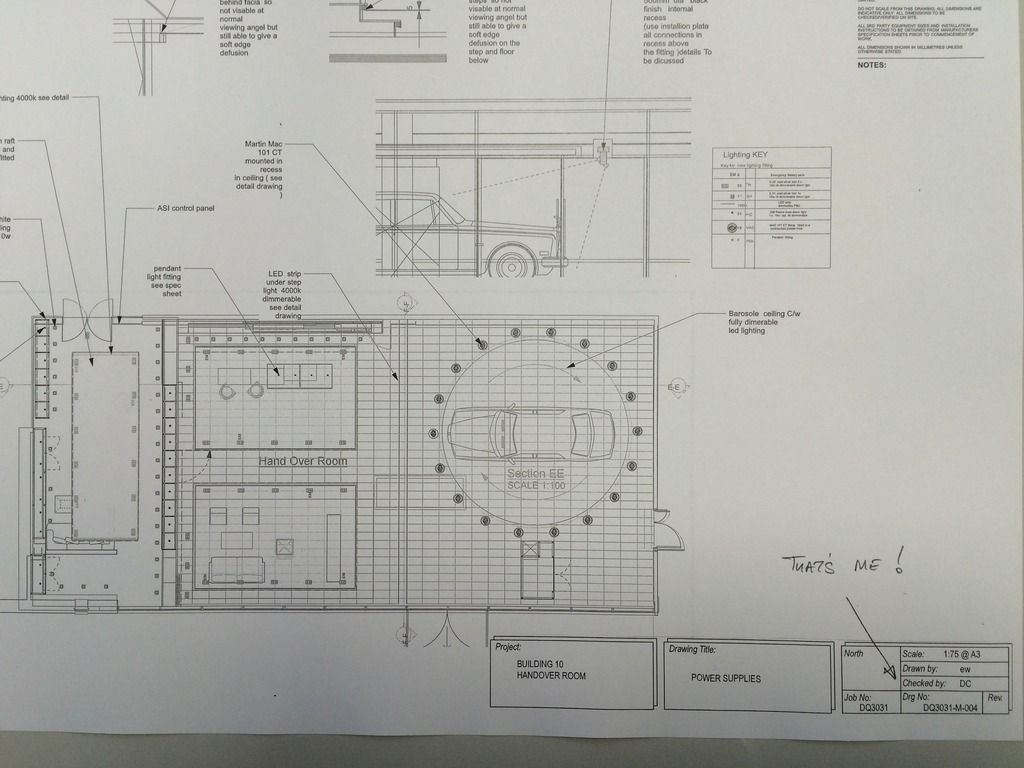
This link is good as it features a great 5 minute film (not sure how long it will be live) of the Customer Design and Handover Centre at Rolls-Royce Goodwood.
A particular favourite area of mine (that I'm proud of) at Goodwood as I was involved in designing and building the various rooms to give the customer the ultimate Rolls-Royce experience you see in the film!
http://www.thisismoney.co.uk/money/cars ... -made.html
I’ll show you an early area design as a lot changed since then so it’s not current.

@classiccarguru1
Re: Rolls-Royce pre-eminent Aero Engine Maker and their cars
So to continue this evening where we left off last night….
To better understand the next evolution of Rolls-Royce & Bentley Motorcars at this point in time of my story, I thought it best to explain what was going on behind the scenes during production of the Silver Cloud & Bentley S Series.
Specialist Engines Division had signed a deal with BMC (British Motor Corporation) to supply engines for the Austin Princess VDP (Vanden Plas) their large luxury car, built from 1947 onwards.
Engineers, Blatchley included at Rolls-Royce Motorcars however viewed this as “a silk purse of an engine in a sows ear of a car”. John told me that “It was not at all attractive”.

Even so, at a lower price than a Rolls-Royce or Bentley, Austin sold enough Princess cars for it to continue in several forms (still with Rolls-Royce engines) until 1968.
The Princess introduced the collaboration of Rolls-Royce, Bentley & BMC in the very early 1960’s to produce a range of smaller saloons and coupes. Working with BMC, R-R developed Monocoque construction which would be incorporated in both manufacturers future models.
John told me “Styling became very much an architectural exercise." His experience back at Gurney Nutting was again to give him the advantage.
“I’d learnt a lot from Mac (A.F.McNeil) on the engineering side. We’d transitioned from Weymann Bodies and I’d worked with Mulliners on the Reynolds frame fastback prototypes, so had a good idea what was required” he said.
There were numerous projects, some records have been lost, but enough is left to tell a story.
Project Java (MkI) started in late 1960. Loosely based on the VDP 3 litre Princess, Blatchley clay modelled some new designs.
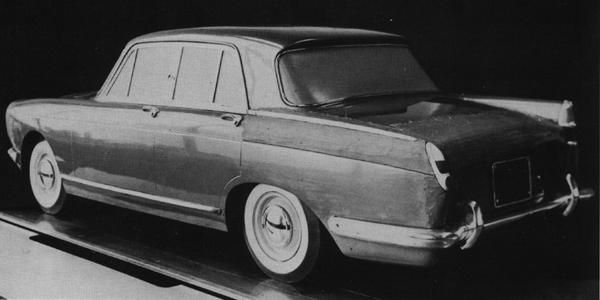
It’s interesting to note in these austere post war times as seen in the picture, the single model had different design features on either side of the car. The angled rear light and rear quarter design is also worth remembering from this 1961 model as it would show up years later on the Corniche.
Java Mk I, never made it past clay.
In 1962 Java II made it to prototype and was used for evaluation and Rolls-Royce engine testing. Again it shows a striking resemblance to the Alvis design that Blatchley would use a few years later through Park Ward. John always seemed to find a way of not letting his work go to waste.
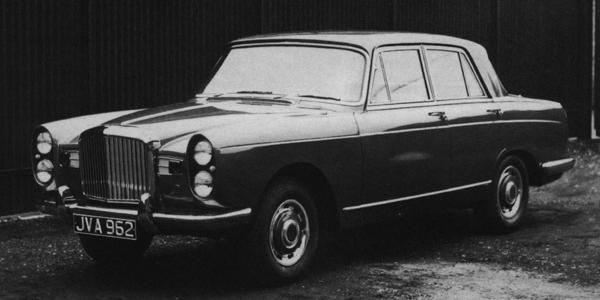
And the Rear

Testing only lasted 1 month when the plugged was pulled on Java II. Rolls-Royce were having reservations about the project and associated Java II as maybe more of a Bentley.
Java III followed leaning towards more of a Rolls-Royce. It was the early seed of what would become Shadow. It is worth pointing out the initials JPB on the number plate (Blatchleys signature)
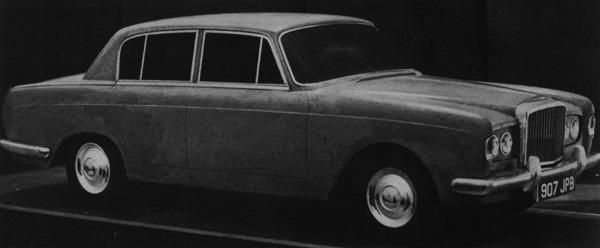
Java was short lived as Rolls-Royce were beginning to get cold feet with BMC and the project ceased at the end of 1962.
The partnership struggled on as Blatchley produced project Bengal & Rangoon
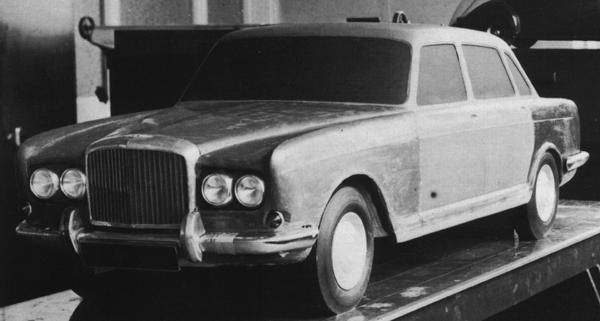
Again like Java I it didn’t get any further than clay with BMC, but added to the stockpile of ideas John had explored leading towards Shadow.
One of the most radical designs in the BMC time was the Bentley Alpha of 1963. The project was for a small Bentley sports coupe as well as a joint effort to replace the Austin Healey 3000 using a shared Rolls-Royce engine and to be built by non other than Pininfarina! The project was cancelled when Jaguar joined BMC group.
The clay prototype again bears a JPB number plate Blatchley signature.
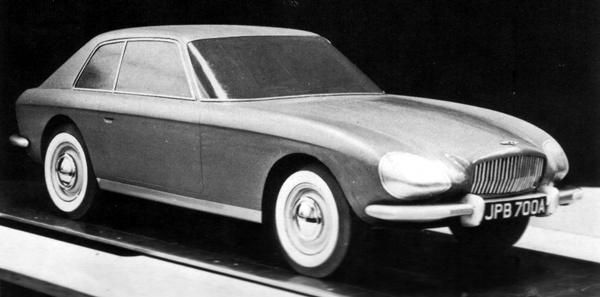
What I find interesting is when this was modelled in 1963 it must have looked completely futuristic (such was the ability of Blatchley to be before his time) It must have stunned Healey and all who saw it.
Had it ever been built it could have changed the destiny of Austin Healey.
After Rolls-Royce parting company with BMC in 1966, if you take the 1962 Bentley Rangoon cabin including the signature window openings, door and in particular the rear quarter window designs and worked on to it an Austin Mini front & rear end, you get a Morris 1800/Wolseley 18/85 Land Crab!
Certainly BMC wouldn’t want to waste the work carried out in the partnership with R-R on these designs. Alec Issigonis is credited with the Morris 1800 Land Crab design, so there’s the Mini front & rear for you!
Unfortunately it’s hard for me to swallow the combined work of two masters, Blatchley & Issigonis resulting in the Land Crab.
To better understand the next evolution of Rolls-Royce & Bentley Motorcars at this point in time of my story, I thought it best to explain what was going on behind the scenes during production of the Silver Cloud & Bentley S Series.
Specialist Engines Division had signed a deal with BMC (British Motor Corporation) to supply engines for the Austin Princess VDP (Vanden Plas) their large luxury car, built from 1947 onwards.
Engineers, Blatchley included at Rolls-Royce Motorcars however viewed this as “a silk purse of an engine in a sows ear of a car”. John told me that “It was not at all attractive”.

Even so, at a lower price than a Rolls-Royce or Bentley, Austin sold enough Princess cars for it to continue in several forms (still with Rolls-Royce engines) until 1968.
The Princess introduced the collaboration of Rolls-Royce, Bentley & BMC in the very early 1960’s to produce a range of smaller saloons and coupes. Working with BMC, R-R developed Monocoque construction which would be incorporated in both manufacturers future models.
John told me “Styling became very much an architectural exercise." His experience back at Gurney Nutting was again to give him the advantage.
“I’d learnt a lot from Mac (A.F.McNeil) on the engineering side. We’d transitioned from Weymann Bodies and I’d worked with Mulliners on the Reynolds frame fastback prototypes, so had a good idea what was required” he said.
There were numerous projects, some records have been lost, but enough is left to tell a story.
Project Java (MkI) started in late 1960. Loosely based on the VDP 3 litre Princess, Blatchley clay modelled some new designs.

It’s interesting to note in these austere post war times as seen in the picture, the single model had different design features on either side of the car. The angled rear light and rear quarter design is also worth remembering from this 1961 model as it would show up years later on the Corniche.
Java Mk I, never made it past clay.
In 1962 Java II made it to prototype and was used for evaluation and Rolls-Royce engine testing. Again it shows a striking resemblance to the Alvis design that Blatchley would use a few years later through Park Ward. John always seemed to find a way of not letting his work go to waste.

And the Rear

Testing only lasted 1 month when the plugged was pulled on Java II. Rolls-Royce were having reservations about the project and associated Java II as maybe more of a Bentley.
Java III followed leaning towards more of a Rolls-Royce. It was the early seed of what would become Shadow. It is worth pointing out the initials JPB on the number plate (Blatchleys signature)

Java was short lived as Rolls-Royce were beginning to get cold feet with BMC and the project ceased at the end of 1962.
The partnership struggled on as Blatchley produced project Bengal & Rangoon

Again like Java I it didn’t get any further than clay with BMC, but added to the stockpile of ideas John had explored leading towards Shadow.
One of the most radical designs in the BMC time was the Bentley Alpha of 1963. The project was for a small Bentley sports coupe as well as a joint effort to replace the Austin Healey 3000 using a shared Rolls-Royce engine and to be built by non other than Pininfarina! The project was cancelled when Jaguar joined BMC group.
The clay prototype again bears a JPB number plate Blatchley signature.

What I find interesting is when this was modelled in 1963 it must have looked completely futuristic (such was the ability of Blatchley to be before his time) It must have stunned Healey and all who saw it.
Had it ever been built it could have changed the destiny of Austin Healey.
After Rolls-Royce parting company with BMC in 1966, if you take the 1962 Bentley Rangoon cabin including the signature window openings, door and in particular the rear quarter window designs and worked on to it an Austin Mini front & rear end, you get a Morris 1800/Wolseley 18/85 Land Crab!
Certainly BMC wouldn’t want to waste the work carried out in the partnership with R-R on these designs. Alec Issigonis is credited with the Morris 1800 Land Crab design, so there’s the Mini front & rear for you!
Unfortunately it’s hard for me to swallow the combined work of two masters, Blatchley & Issigonis resulting in the Land Crab.
@classiccarguru1
Re: Rolls-Royce pre-eminent Aero Engine Maker and their cars
Tonight we move on to the Silver Shadow and its equivalent the Bentley T series for which Blatchley is probably most remembered.
The model ran from 1965–1980 and was at the time the most successful car, in terms of sales, that Rolls-Royce had built with 30,057 made.
The Silver Shadow (or as now commonly/mistakenly referred to as Shadow I) was produced from 1965 to 1976
Code name SY series started in 1954 named after exotic Far Eastern regions (names chosen by Rolls-Royces Engineering Director Harry Grylls). It was Rolls-Royces first monocoque car, ending it’s 60 year history of producing Chassis, and putting a nail in the coffin for the independent coachbuilders. Shadow was to be lighter, stiffer, stronger and more spacious.
Over several visits to John at his home in Hastings we discussed the Project.
“We hadn’t even finalised Cloud when Harry made the announcement of its replacement” John told me.
“It was a slow starter because we were busy with other projects. I was working on a luxury saloon with a fellow at Alvis, you’ve probably heard of. Their designer, Alec Issigonis”.
John had done it again, casually dropping a bombshell into our conversation to grab my interest.
“Issigonis!” I replied.
“Yes. We’d come up with new saloon for us to evaluate at Park Ward but Alvis thought it would be too expensive and scrapped the idea. It frustrated Alec & me as we both thought the project had innovative ideas on increasing passenger and boot space”.
“You’re describing the Mini, John!”
“Oh, no not quite, this was a big saloon car. I styled the interior and shaped the doors so that they were concave and increased passenger space without making the car any wider outside, and all that” John said modestly.
“Alec got a flea in his ear when Alvis rejected the design on cost and left for BMC”
As they say, the rest was history.
John had a series of early design drawings that he shared with me.
“This one is the first Tibet” John said as he handed me a pastel drawing of a 4 door saloon.
Tibet was the named given to project SY for the Rolls-Royce and Burma was its Bentley equivalent.
I could see similarities with the BMC co-operation cars in this early picture before me.
“Look here” said John pointing at the side profile of the car in the picture. “Curved side windows”
“Curved side windows? In when 1955? I replied.
“Yes. With curved glass it dropped into the door and allowed the passenger space to be a good 6” wider without the car being wider” John explained. “It was a very good idea, but Harry wasn’t convinced as it made his engineering a little harder” (Harry was Harry Grylls) “We had quite a lot of arguments over this. It got so bad it went straight to Hives himself” (Hives was Lord Hives the MD & Chairman of Rolls-Royce) “I was over ruled and told to use flat door glass. It was cheaper to manufacture, cheaper to engineer the window mechanisms, took less space to store at the factory and as a consequence was cheaper to transport. You only needed to make one set as the left side would fit the right”
This is why today if you look at any Silver Shadow or T Series car, the Triplex mark is reversed on one side of the car as it’s the same piece of glass for each side.
“I was never really happy at Rolls-Royce after that. The design was compromised over a few pennies for glass and the interior space narrowed. We were building a Rolls-Royce for goodness sake”
I asked tentatively “Is this what led you to leave in 69?”
“Partly” John replied.
The project pushed ahead with flat door glass and the form of the car took shape.

The first prototype Rolls-Royce Tibet was completed early 1958 following an uncertain delay caused by the Suez Oil Crisis which nearly killed it off.
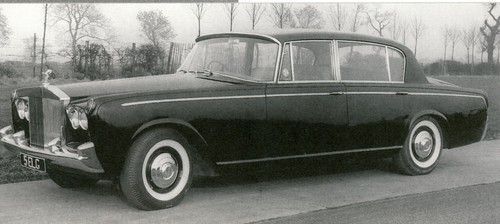
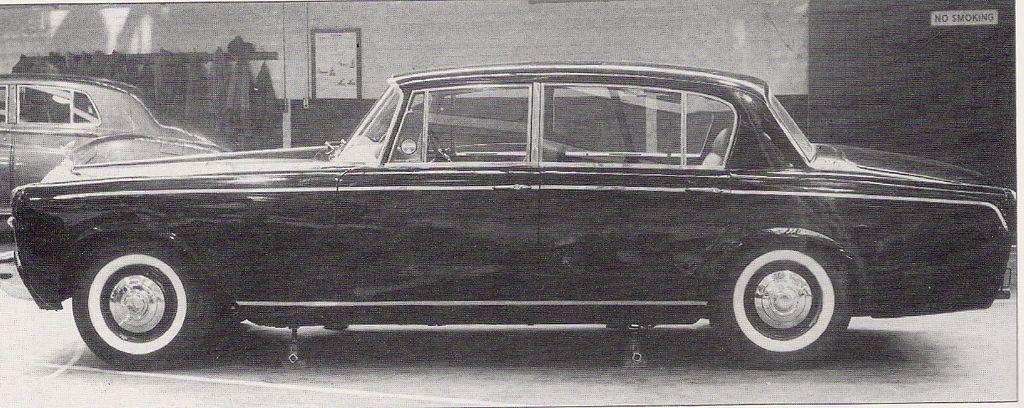
“We needed to differentiate between brands so the front was restyled for the Bentley” John handed me another drawing.
The prototype Bentley Burma followed in 1960 after long testing and evaluation of Tibet.
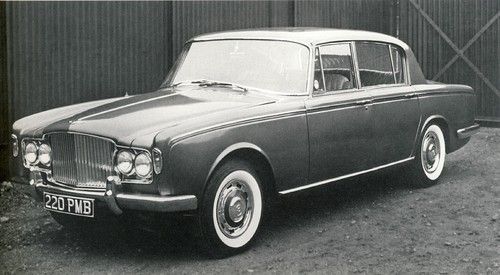
Again Burma was used for engine & suspension testing.
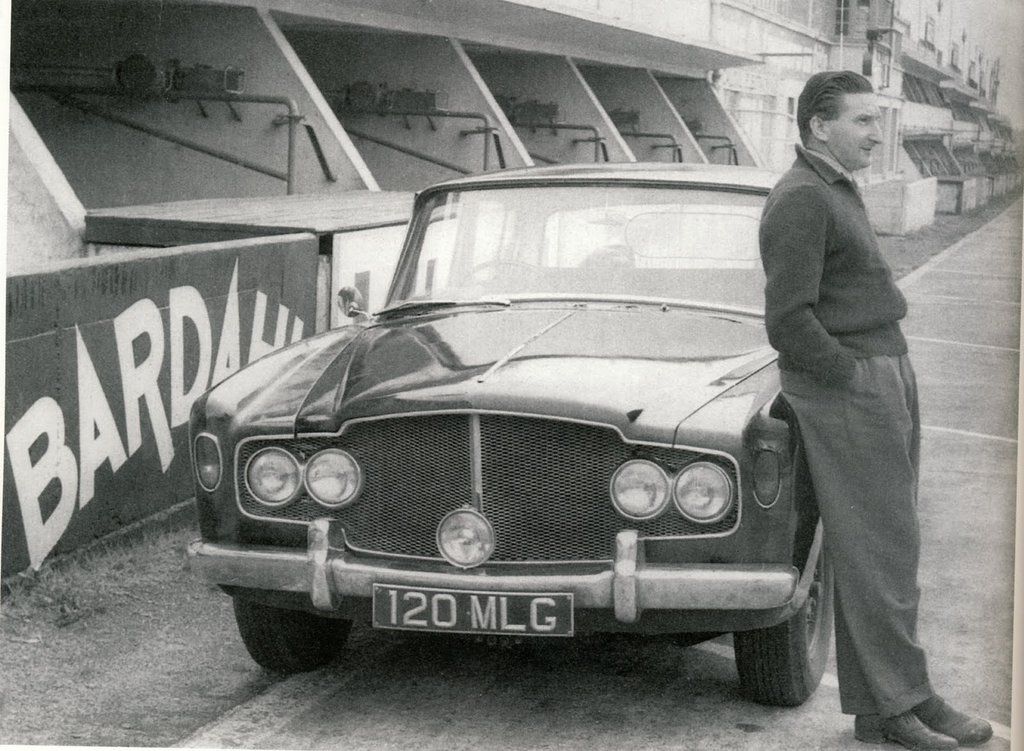
Further delays to the project (resulting in continued model series to Cloud, I, II & III) was the introduction of new Crash Testing Regulations.
“After crash testing we changed the shape of the C pillar and a few other details, but it was mainly the engineering department who got homework” John told me.

These few changes were modelled by John in the picture below, which is almost the final design for the Silver Shadow.
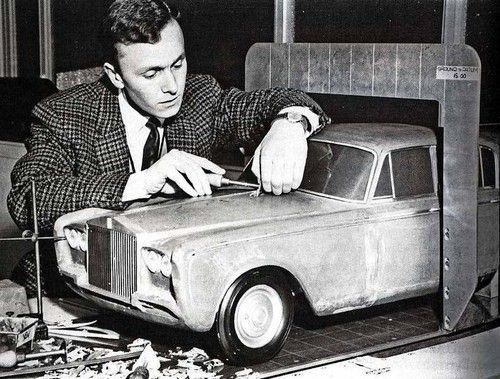
Eventually John Blatchley had a perfected the shape and is shown below with final Shadow in the company of the management. The car was 3 1⁄2 inches narrower & 7 inches shorter than the Silver Cloud it replaced with more passenger and luggage space available even with flat glass.
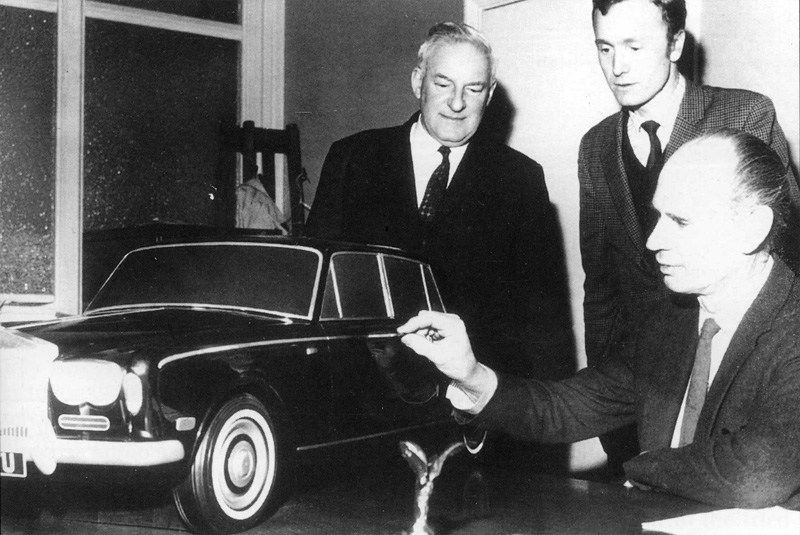
The first shadow prototype bodies were coachbuilt in house.
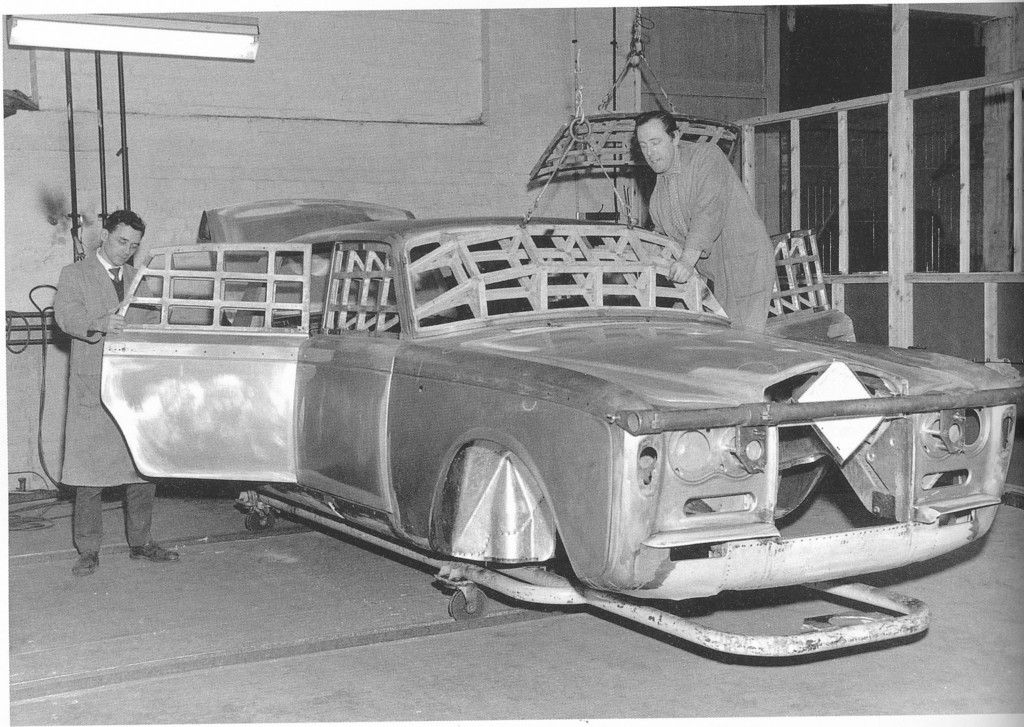
All that was left to do was Crash Test the final design to get approval for production.
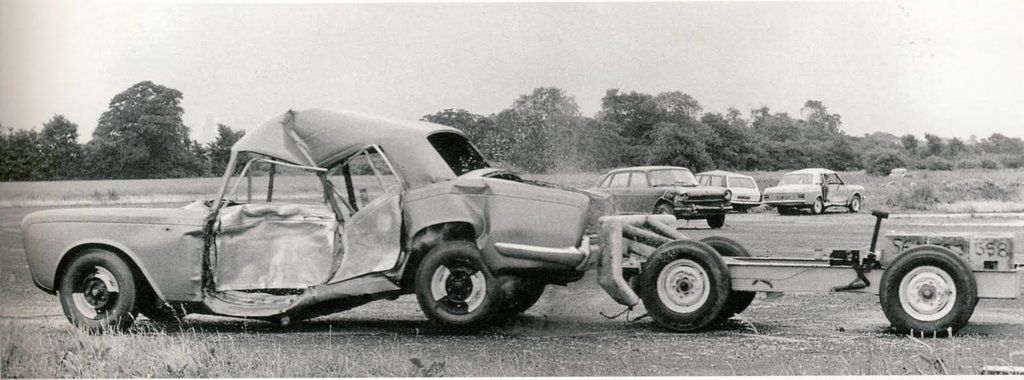

The Body was made under contract as for previous models by Pressed Steel of Cowley
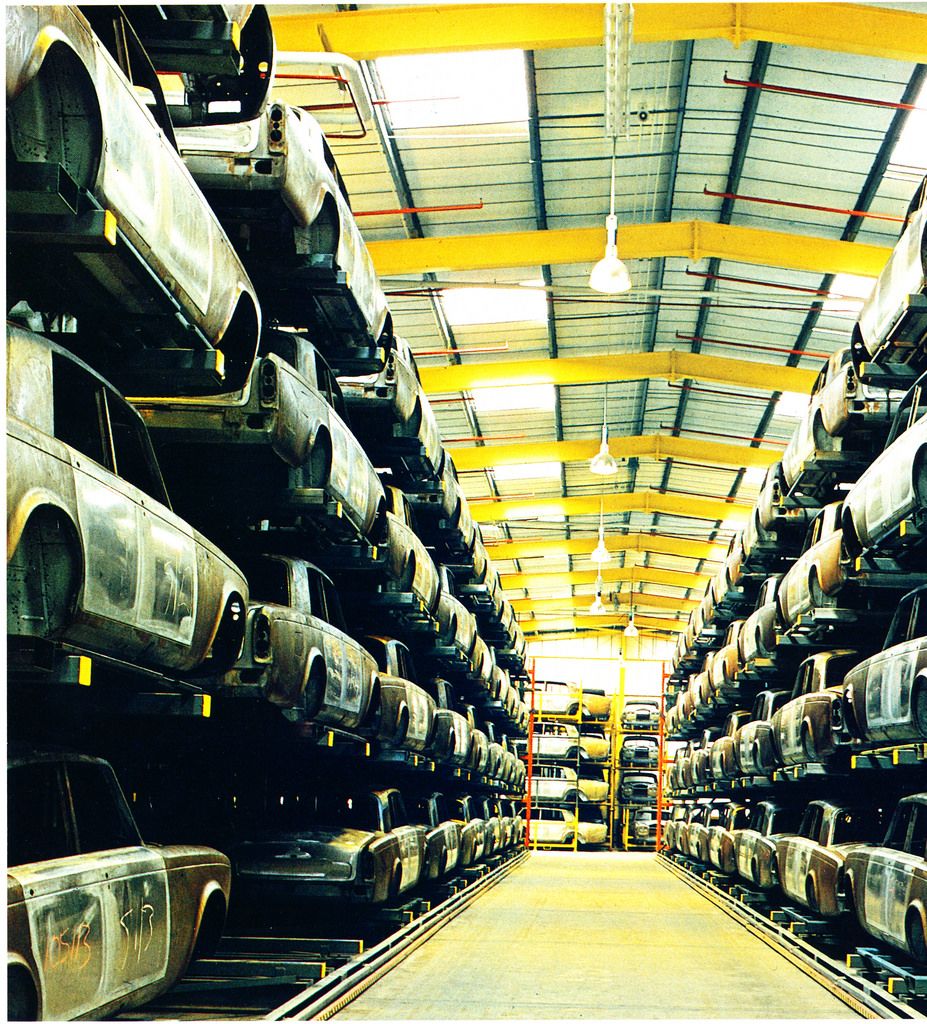
Production started in 1964 at Crewe.
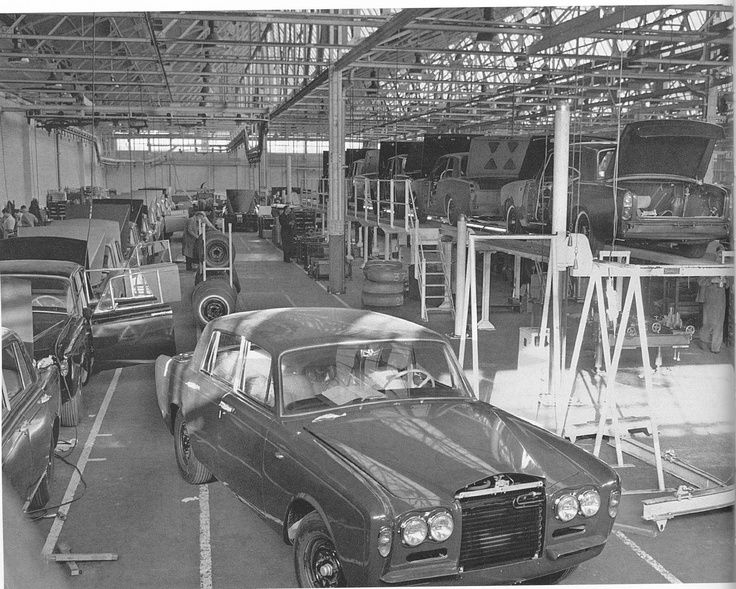
The 1965 Rolls-Royce Silver Shadow
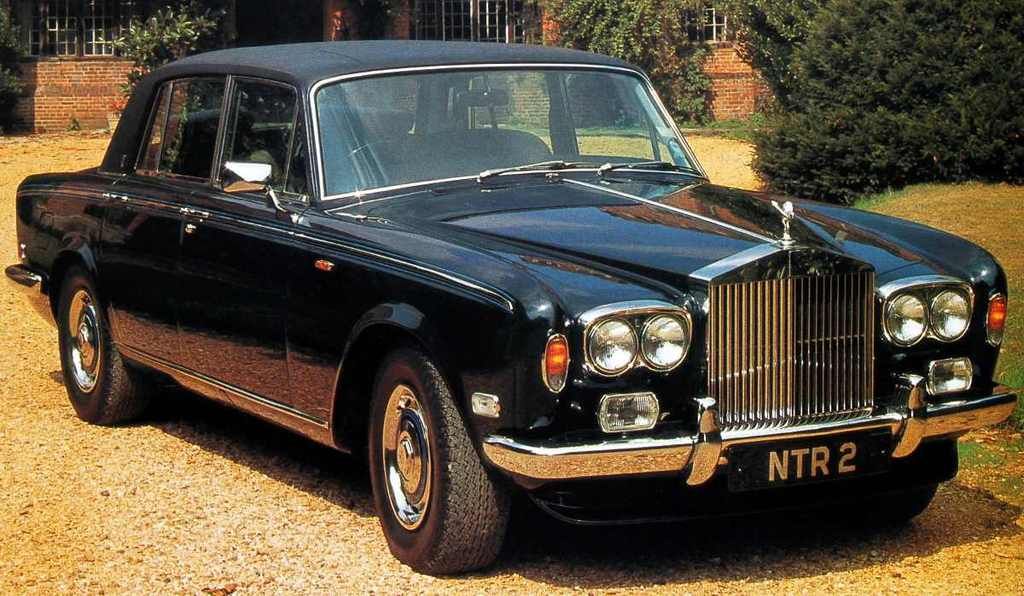
The all new interior
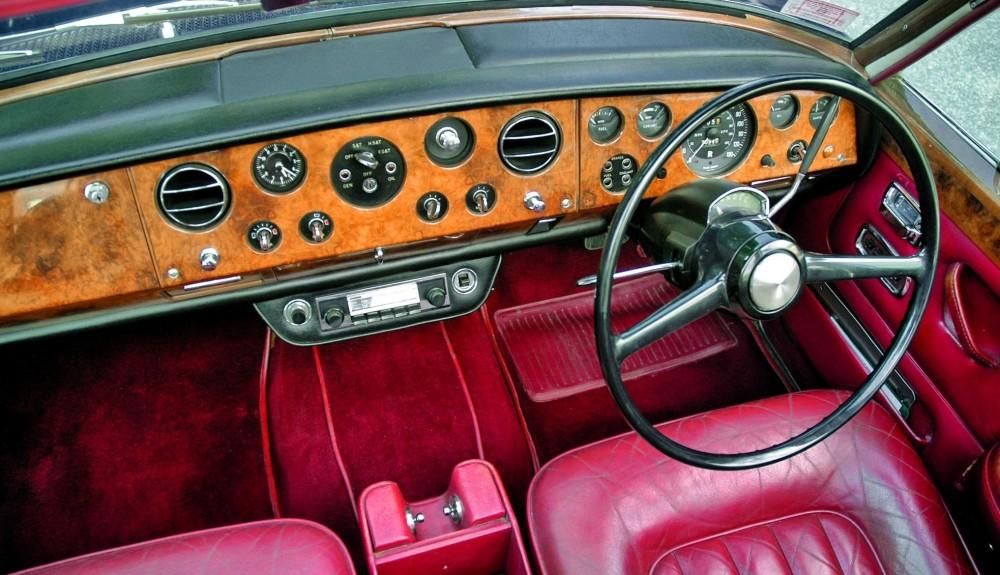
And the 1965 Bentley T

I wanted to understand more about why in 4 years-time Blatchley would walk out on Rolls-Royce…..
The model ran from 1965–1980 and was at the time the most successful car, in terms of sales, that Rolls-Royce had built with 30,057 made.
The Silver Shadow (or as now commonly/mistakenly referred to as Shadow I) was produced from 1965 to 1976
Code name SY series started in 1954 named after exotic Far Eastern regions (names chosen by Rolls-Royces Engineering Director Harry Grylls). It was Rolls-Royces first monocoque car, ending it’s 60 year history of producing Chassis, and putting a nail in the coffin for the independent coachbuilders. Shadow was to be lighter, stiffer, stronger and more spacious.
Over several visits to John at his home in Hastings we discussed the Project.
“We hadn’t even finalised Cloud when Harry made the announcement of its replacement” John told me.
“It was a slow starter because we were busy with other projects. I was working on a luxury saloon with a fellow at Alvis, you’ve probably heard of. Their designer, Alec Issigonis”.
John had done it again, casually dropping a bombshell into our conversation to grab my interest.
“Issigonis!” I replied.
“Yes. We’d come up with new saloon for us to evaluate at Park Ward but Alvis thought it would be too expensive and scrapped the idea. It frustrated Alec & me as we both thought the project had innovative ideas on increasing passenger and boot space”.
“You’re describing the Mini, John!”
“Oh, no not quite, this was a big saloon car. I styled the interior and shaped the doors so that they were concave and increased passenger space without making the car any wider outside, and all that” John said modestly.
“Alec got a flea in his ear when Alvis rejected the design on cost and left for BMC”
As they say, the rest was history.
John had a series of early design drawings that he shared with me.
“This one is the first Tibet” John said as he handed me a pastel drawing of a 4 door saloon.
Tibet was the named given to project SY for the Rolls-Royce and Burma was its Bentley equivalent.
I could see similarities with the BMC co-operation cars in this early picture before me.
“Look here” said John pointing at the side profile of the car in the picture. “Curved side windows”
“Curved side windows? In when 1955? I replied.
“Yes. With curved glass it dropped into the door and allowed the passenger space to be a good 6” wider without the car being wider” John explained. “It was a very good idea, but Harry wasn’t convinced as it made his engineering a little harder” (Harry was Harry Grylls) “We had quite a lot of arguments over this. It got so bad it went straight to Hives himself” (Hives was Lord Hives the MD & Chairman of Rolls-Royce) “I was over ruled and told to use flat door glass. It was cheaper to manufacture, cheaper to engineer the window mechanisms, took less space to store at the factory and as a consequence was cheaper to transport. You only needed to make one set as the left side would fit the right”
This is why today if you look at any Silver Shadow or T Series car, the Triplex mark is reversed on one side of the car as it’s the same piece of glass for each side.
“I was never really happy at Rolls-Royce after that. The design was compromised over a few pennies for glass and the interior space narrowed. We were building a Rolls-Royce for goodness sake”
I asked tentatively “Is this what led you to leave in 69?”
“Partly” John replied.
The project pushed ahead with flat door glass and the form of the car took shape.

The first prototype Rolls-Royce Tibet was completed early 1958 following an uncertain delay caused by the Suez Oil Crisis which nearly killed it off.


“We needed to differentiate between brands so the front was restyled for the Bentley” John handed me another drawing.
The prototype Bentley Burma followed in 1960 after long testing and evaluation of Tibet.

Again Burma was used for engine & suspension testing.

Further delays to the project (resulting in continued model series to Cloud, I, II & III) was the introduction of new Crash Testing Regulations.
“After crash testing we changed the shape of the C pillar and a few other details, but it was mainly the engineering department who got homework” John told me.

These few changes were modelled by John in the picture below, which is almost the final design for the Silver Shadow.

Eventually John Blatchley had a perfected the shape and is shown below with final Shadow in the company of the management. The car was 3 1⁄2 inches narrower & 7 inches shorter than the Silver Cloud it replaced with more passenger and luggage space available even with flat glass.

The first shadow prototype bodies were coachbuilt in house.

All that was left to do was Crash Test the final design to get approval for production.


The Body was made under contract as for previous models by Pressed Steel of Cowley

Production started in 1964 at Crewe.

The 1965 Rolls-Royce Silver Shadow

The all new interior

And the 1965 Bentley T

I wanted to understand more about why in 4 years-time Blatchley would walk out on Rolls-Royce…..
@classiccarguru1
Re: Rolls-Royce pre-eminent Aero Engine Maker and their cars
Fascinating and amazing to think the length of career/influence? I can see Mulsanne/Turbo R in the Bengal...
Harry not directly related to Bear...
And you'll be able to answer this, Darren. Since dad had a Shadow and a Shadow 2 way back, I've wondered if there's any significance to the xxxTU number plate.
Harry not directly related to Bear...
And you'll be able to answer this, Darren. Since dad had a Shadow and a Shadow 2 way back, I've wondered if there's any significance to the xxxTU number plate.
02 986 Boxster
68 T Sporto (sold)
91 964 C2 Tip (sold)
68 T Sporto (sold)
91 964 C2 Tip (sold)
Re: Rolls-Royce pre-eminent Aero Engine Maker and their cars
Thanks Tosh.
Rolls-Royce and Bentley Motors own a series of registration plates with TU & WO numbers mostly seen in promotional photos. (like the 911 HUL owned by Porsche UK) When VW purchased Bentley in 2001 they got the asset, so now own these registation plates. Obviously WO is Walter Owen. TU is the area code for Cheshire & Crewe.
Rolls-Royce and Bentley Motors own a series of registration plates with TU & WO numbers mostly seen in promotional photos. (like the 911 HUL owned by Porsche UK) When VW purchased Bentley in 2001 they got the asset, so now own these registation plates. Obviously WO is Walter Owen. TU is the area code for Cheshire & Crewe.
@classiccarguru1
-
shoestring7
- DDK rules my life!
- Posts: 1169
- Joined: Sun Feb 15, 2009 8:45 pm
- Location: Goodwood, West Sussex
- Contact:
Re: Rolls-Royce pre-eminent Aero Engine Maker and their cars
In 1989 I spent a summer working as a gofer for a high-end classic car dealer called The Paradise Garage. They were based in a mews in Clapham Old Town, and specialised in 'serious' British stuff: WO Bentleys, Lagondas, RR, Astons and the odd XK Jag. In the corner for the whole time I was there was the Embiricos Bentley. I think it was being stored for the owner - certainly I don't remember that it was for sale. I believe it was a mid-blue colour at the time, but I think it's been changed subsequently.Darren C wrote:
Evernden had been tasked to produce a Coachbuilt Bentley to build alongside the standard Bentley MkVI. Blatchley was employed as chief stylist. The brief was that it should follow in the footsteps of the 1938 4½ litre “Embricos” Bentley originally built in Paris, under the guidance of the Bentley Motors development engineers. The coachwork was designed by Georges Paulin and built by Van Vooren but without doubt drew inspiration from earlier Pininfarina Coachwork fitted to cars such as the Alfa Romeo 6C 2300 Pescara Berlinetta Aerodynamica. (I told you all this was intertwined!)
As part of my duties I used to gently take the dust off each morning, and once when the bosses were out I slipped behind the wheel and made brmm brmm noises
Here's a very young me with one of the stock - we used to take cars to a spot on the Common to take pictures, and once I'd proved I wasn't a nutter I was allowed to drive!

Note the polishing cloth in my hand!
>Charles
968C/968CS/'92 964C4/944t/924S Trackday shed/Cayman/964C2#2/'73 hotrod (gone)
Mini JCW buzzbox
Audi A2 Piech edition
BMW R1250GSA
http://thecarlistblog.blogspot.co.uk/
Mini JCW buzzbox
Audi A2 Piech edition
BMW R1250GSA
http://thecarlistblog.blogspot.co.uk/
Re: Rolls-Royce pre-eminent Aero Engine Maker and their cars
Elwood Engles and Eugene Bordinat's work on the '61-65 Lincoln Continental is interesting as a comparison. They moved to a monocoque and slab sided suit that many see as the high tide of American styling.
Scene tax

